Yamaha HTR-6150 User Manual

UC
HTR-6150
AV Receiver Ampli-tuner audio-vidéo
OWNER’S MANUAL MODE D’EMPLOI
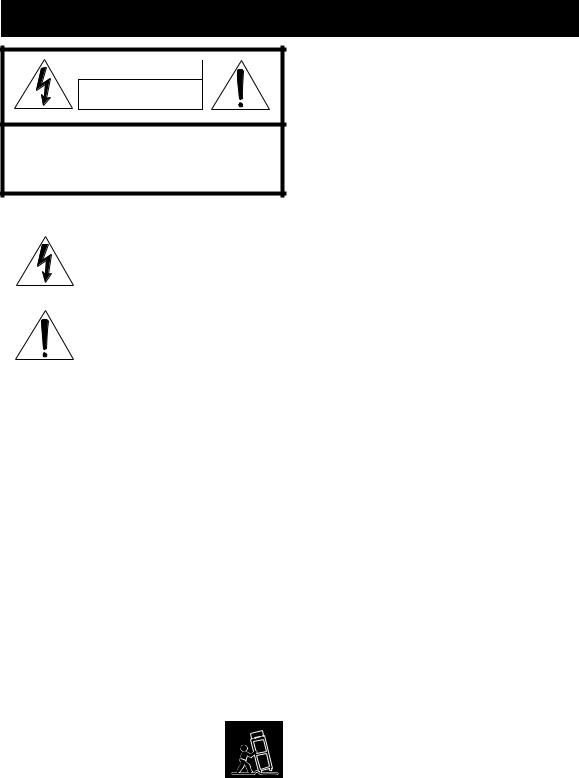
IMPORTANT SAFETY INSTRUCTIONS
CAUTION |
RISK OF ELECTRIC SHOCK |
DO NOT OPEN |
CAUTION: TO REDUCE THE RISK OF |
ELECTRIC SHOCK, DO NOT REMOVE |
COVER (OR BACK). NO USER-SERVICEABLE |
PARTS INSIDE. REFER SERVICING TO |
QUALIFIED SERVICE PERSONNEL. |
•Explanation of Graphical Symbols
The lightning flash with arrowhead symbol, within an equilateral triangle, is intended to alert you to the presence of uninsulated “dangerous voltage” within the product’s enclosure that may be of sufficient magnitude to constitute a risk of electric shock to persons.
The exclamation point within an equilateral triangle is intended to alert you to the presence of important operating and maintenance (servicing) instructions in the literature accompanying the appliance.
1Read Instructions – All the safety and operating instructions should be read before the product is operated.
2Retain Instructions – The safety and operating instructions should be retained for future reference.
3Heed Warnings – All warnings on the product and in the operating instructions should be adhered to.
4Follow Instructions – All operating and use instructions should be followed.
5Cleaning – Unplug this product from the wall outlet before cleaning. Do not use liquid cleaners or aerosol cleaners.
6Attachments – Do not use attachments not recommended by the product manufacturer as they may cause hazards.
7Water and Moisture – Do not use this product near water – for example, near a bath tub, wash bowl, kitchen sink, or laundry tub; in a wet basement; or near a swimming pool; and the like.
8Accessories – Do not place this product on an unstable cart, stand, tripod, bracket, or table. The product may fall, causing serious injury to a child or adult, and serious damage to the product. Use only with a cart, stand, tripod, bracket, or table recommended by the manufacturer, or sold with the product. Any mounting of the product should follow the manufacturer’s instructions, and should use a mounting accessory recommended by the manufacturer.
9A product and cart combination should be moved with care. Quick stops, excessive force, and uneven surfaces may cause the product and cart combination to
overturn.
10Ventilation – Slots and openings in the cabinet are provided for ventilation and to ensure reliable operation of the product and to protect it from overheating, and these openings must not be blocked or covered. The openings should never be blocked by placing the product on a bed, sofa, rug, or other similar surface. This product should not be placed in a built-in installation such as a bookcase or rack unless proper ventilation is provided or the manufacturer’s instructions have been adhered to.
11Power Sources – This product should be operated only from the type of power source indicated on the marking label. If you are not sure of the type of power supply to your home, consult your product dealer or local power company. For products intended to operate from battery power, or other sources, refer to the operating instructions.
12Grounding or Polarization – This product may be equipped with a polarized alternating current line plug (a plug having one blade wider than the other). This plug will fit into the power outlet only one way. This is a safety feature. If you are unable to insert the plug fully into the outlet, try reversing the plug. If the plug should still fail to fit, contact your electrician to replace your obsolete outlet. Do not defeat the safety purpose of the polarized plug.
13Power-Cord Protection – Power-supply cords should be routed so that they are not likely to be walked on or pinched by items placed upon or against them, paying particular attention to cords at plugs, convenience receptacles, and the point where they exit from the product.
14Lightning – For added protection for this product during a lightning storm, or when it is left unattended and unused for long periods of time, unplug it from the wall outlet and disconnect the antenna or cable system. This will prevent damage to the product due to lightning and power-line surges.
15Power Lines – An outside antenna system should not be located in the vicinity of overhead power lines or other electric light or power circuits, or where it can fall into such power lines or circuits. When installing an outside antenna system, extreme care should be taken to keep from touching such power lines or circuits as contact with them might be fatal.
16Overloading – Do not overload wall outlets, extension cords, or integral convenience receptacles as this can result in a risk of fire or electric shock.
17Object and Liquid Entry – Never push objects of any kind into this product through openings as they may touch dangerous voltage points or short-out parts that could result in a fire or electric shock. Never spill liquid of any kind on the product.
18Servicing – Do not attempt to service this product yourself as opening or removing covers may expose you to dangerous voltage or other hazards. Refer all servicing to qualified service personnel.
19Damage Requiring Service – Unplug this product from the wall outlet and refer servicing to qualified service personnel under the following conditions:
a)When the power-supply cord or plug is damaged,
b)If liquid has been spilled, or objects have fallen into the product,
c)If the product has been exposed to rain or water,
Caution-i En
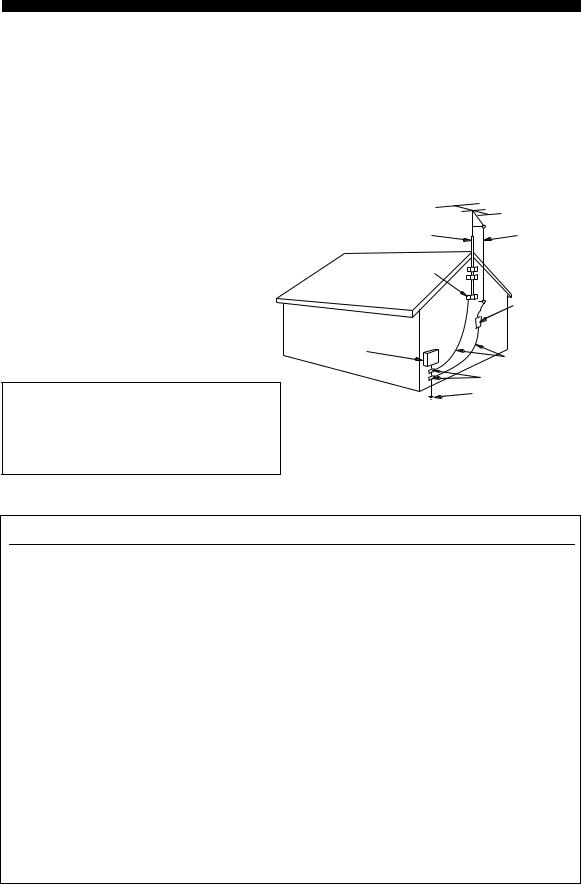
d)If the product does not operate normally by following the operating instructions. Adjust only those controls that are covered by the operating instructions as an improper adjustment of other controls may result in damage and will often require extensive work by a qualified technician to restore the product to its normal operation,
e)If the product has been dropped or damaged in any way, and
f)When the product exhibits a distinct change in perfor-
mance - this indicates a need for service.
20Replacement Parts – When replacement parts are required, be sure the service technician has used replacement parts specified by the manufacturer or have the same characteristics as the original part. Unauthorized substitutions may result in fire, electric shock, or other hazards.
21Safety Check – Upon completion of any service or repairs to this product, ask the service technician to perform safety checks to determine that the product is in proper operating condition.
22Wall or Ceiling Mounting – The unit should be mounted to a wall or ceiling only as recommended by the manufacturer.
23Heat – The product should be situated away from heat sources such as radiators, heat registers, stoves, or other products (including amplifiers) that produce heat.
Note to CATV system installer:
This reminder is provided to call the CATV system installer’s attention to Article 820-40 of the NEC that provides guidelines for proper grounding and, in particular, specifies that the cable ground shall be connected to the grounding system of the building, as close to the point of cable entry as practical.
IMPORTANT SAFETY INSTRUCTIONS
24Outdoor Antenna Grounding – If an outside antenna or cable system is connected to the product, be sure the antenna or cable system is grounded so as to provide some protection against voltage surges and built-up static charges. Article 810 of the National Electrical Code, ANSI/NFPA 70, provides information with regard to proper grounding of the mast and supporting structure, grounding of the lead-in wire to an antenna discharge unit, size of grounding conductors, location of antenna discharge unit, connection to grounding electrodes, and requirements for the grounding electrode.
EXAMPLE OF ANTENNA GROUNDING
MAST |
ANTENNA |
|
LEAD IN |
|
WIRE |
GROUND |
|
CLAMP |
|
|
ANTENNA |
|
DISCHARGE UNIT |
|
(NEC SECTION 810–20) |
ELECTRIC |
|
SERVICE |
|
EQUIPMENT |
GROUNDING CONDUCTORS |
|
|
|
(NEC SECTION 810–21) |
|
GROUND CLAMPS |
|
POWER SERVICE GROUNDING |
|
ELECTRODE SYSTEM |
|
(NEC ART 250. PART H) |
NEC – NATIONAL ELECTRICAL CODE |
|
FCC INFORMATION (for US customers)
1IMPORTANT NOTICE: DO NOT MODIFY THIS UNIT!
This product, when installed as indicated in the instructions contained in this manual, meets FCC requirements. Modifications not expressly approved by Yamaha may void your authority, granted by the FCC, to use the product.
2IMPORTANT: When connecting this product to accessories and/or another product use only high quality shielded cables. Cable/s supplied with this product MUST be used. Follow all installation instructions. Failure to follow instructions could void your FCC authorization to use this product in the USA.
3NOTE: This product has been tested and found to comply with the requirements listed in FCC Regulations, Part 15 for Class “B” digital devices. Compliance with these requirements provides a reasonable level of assurance that your use of this product in a residential environment will not result in harmful interference with other electronic devices.
This equipment generates/uses radio frequencies and, if not installed and used according to the instructions found in the users manual, may cause interference harmful to the operation of other electronic devices.
Compliance with FCC regulations does not guarantee that interference will not occur in all installations. If this product is found to be the source of interference, which can be determined by turning the unit “OFF” and “ON”, please try to eliminate the problem by using one of the following measures:
Relocate either this product or the device that is being affected by the interference.
Utilize power outlets that are on different branch (circuit breaker or fuse) circuits or install AC line filter/s.
In the case of radio or TV interference, relocate/reorient the antenna. If the antenna lead-in is 300 ohm ribbon lead, change the lead-in to coaxial type cable.
If these corrective measures do not produce satisfactory results, please contact the local retailer authorized to distribute this type of product. If you can not locate the appropriate retailer, please contact Yamaha Electronics Corp., U.S.A. 6660 Orangethorpe Ave., Buena Park, CA 90620.
The above statements apply ONLY to those products distributed by Yamaha Corporation of America or its subsidiaries.
Caution-ii En

Caution: Read this before operating your unit.
1To assure the finest performance, please read this manual carefully. Keep it in a safe place for future reference.
2Install this sound system in a well ventilated, cool, dry, clean place – away from direct sunlight, heat sources, vibration, dust, moisture, and/or cold. Allow ventilation space of at least 30 cm on the top, 20 cm on the left and right, and 20 cm on the back of this unit.
3Locate this unit away from other electrical appliances, motors, or transformers to avoid humming sounds.
4Do not expose this unit to sudden temperature changes from cold to hot, and do not locate this unit in a environment with high humidity (i.e. a room with a humidifier) to prevent condensation inside this unit, which may cause an electrical shock, fire, damage to this unit, and/or personal injury.
5Avoid installing this unit where foreign object may fall onto this unit and/or this unit may be exposed to liquid dripping or splashing. On the top of this unit, do not place:
–other components, as they may cause damage and/or discoloration on the surface of this unit.
–burning objects (i.e. candles), as they may cause fire, damage to this unit, and/or personal injury.
–containers with liquid in them, as they may fall and liquid may cause electrical shock to the user and/or damage to this unit.
6Do not cover this unit with a newspaper, tablecloth, curtain, etc. in order not to obstruct heat radiation. If the temperature inside this unit rises, it may cause fire, damage to this unit, and/or personal injury.
7Do not plug in this unit to a wall outlet until all connections are complete.
8Do not operate this unit upside-down. It may overheat, possibly causing damage.
9Do not use force on switches, knobs and/or cords.
10When disconnecting the power cable from the wall outlet, grasp the plug; do not pull the cord.
11Do not clean this unit with chemical solvents; this might damage the finish. Use a clean, dry cloth.
12Only voltage specified on this unit must be used. Using this unit with a higher voltage than specified is dangerous and may cause fire, damage to this unit, and/or personal injury. Yamaha will not be held responsible for any damage resulting from use of this unit with a voltage other than specified.
13To prevent damage by lightning, keep the power cord and outdoor antennas disconnected from a wall outlet or the unit during a lightning storm.
14Do not attempt to modify or fix this unit. Contact qualified Yamaha service personnel when any service is needed. The cabinet should never be opened for any reasons.
15When not planning to use this unit for long periods of time (i.e. vacation), disconnect the AC power plug from the wall outlet.
16Install this unit near the AC outlet and where the AC power plug can be reached easily.
17Be sure to read the “Troubleshooting” section on common operating errors before concluding that this unit is faulty.
18Before moving this unit, press CSYSTEM OFF to set this unit in the standby mode, and disconnect the AC power plug from the wall outlet.
19VOLTAGE SELECTOR (Asia and General models only) The VOLTAGE SELECTOR on the rear panel of this unit must be set for your local main voltage BEFORE plugging into the AC wall outlet.
Voltages are 110–120/220–240 V AC, 50/60 Hz.
20The batteries shall not be exposed to excessive heat such as sunshine, fire or like.
21Excessive sound pressure from earphones and headphones can cause hearing loss.
WARNING
TO REDUCE THE RISK OF FIRE OR ELECTRIC SHOCK, DO NOT EXPOSE THIS UNIT TO RAIN OR MOISTURE.
This unit is not disconnected from the AC power source as long as it is connected to the wall outlet, even if this unit itself is turned off by CSYSTEM OFF. This state is called the standby mode. In this state, this unit is designed to consume a very small quantity of power.
FOR CANADIAN CUSTOMERS
To prevent electric shock, match wide blade of plug to wide slot and fully insert.
This Class B digital apparatus complies with Canadian ICES-003.
IMPORTANT
Please record the serial number of this unit in the space below.
MODEL:
Serial No.:
The serial number is located on the rear of the unit. Retain this Owner’s Manual in a safe place for future reference.
Caution-iii En

Contents
INTRODUCTION |
|
Features ................................................................... |
2 |
Getting started ........................................................ |
3 |
Quick start guide .................................................... |
4 |
Preparation: Check the items ..................................... |
4 |
Step 1: Set up your speakers...................................... |
5 |
Step 2: Connect your DVD player and other |
|
components............................................................ |
6 |
Step 3: Press SCENE 1 button................................... |
7 |
What do you want to do with this unit?..................... |
8 |
PREPARATION |
|
Connections ............................................................. |
9 |
Rear panel .................................................................. |
9 |
Placing speakers....................................................... |
10 |
Connecting speakers ................................................ |
11 |
Information on jacks and cable plugs ...................... |
13 |
Information on HDMI™.......................................... |
14 |
Audio and video signal flow.................................... |
15 |
Connecting video components................................. |
16 |
Connecting other components ................................. |
17 |
Connecting audio components................................. |
19 |
Connecting a Yamaha iPod™ universal dock or |
|
Bluetooth™ adapter............................................. |
20 |
Using REMOTE IN/OUT jacks............................... |
20 |
Using the VIDEO AUX jacks on the front panel .... |
21 |
Connecting the FM and AM antennas ..................... |
21 |
Connecting the power cable..................................... |
22 |
Setting the speaker impedance................................. |
23 |
Turning on and off the power .................................. |
23 |
Front panel display .................................................. |
24 |
Optimizing the speaker setting |
|
for your listening room .................................... |
26 |
Using AUTO SETUP .............................................. |
26 |
BASIC OPERATION |
|
Selecting the SCENE templates........................... |
30 |
Selecting the desired SCENE template.................... |
30 |
Creating your original SCENE templates................ |
33 |
Using remote control on the SCENE feature........... |
34 |
Playback ................................................................ |
35 |
Basic operations....................................................... |
35 |
Selecting audio input jacks |
|
(AUDIO SELECT).............................................. |
36 |
Selecting the MULTI CH INPUT component......... |
36 |
Displaying the current status of this unit on a video |
|
monitor ................................................................ |
37 |
Using your headphones............................................ |
37 |
Muting the audio output........................................... |
37 |
Playing video sources in the background of an audio |
|
source................................................................... |
38 |
Displaying the input source information ................. |
38 |
Using the sleep timer ............................................... |
39 |
Sound field programs ........................................... |
40 |
Sound field program descriptions............................ |
40 |
Using audio features ............................................. |
43 |
Enjoying high quality sound.................................... |
43 |
Adjusting the tonal quality....................................... |
43 |
Adjusting the speaker level...................................... |
43 |
Selecting the night listening mode........................... |
44 |
FM/AM tuning ...................................................... |
45 |
Automatic tuning ..................................................... |
45 |
Manual tuning.......................................................... |
45 |
Automatic preset tuning........................................... |
46 |
Manual preset tuning ............................................... |
46 |
Selecting preset stations........................................... |
47 |
Exchanging preset station ........................................ |
47 |
XM Satellite Radio tuning .................................... |
48 |
Connecting the XM Mini-Tuner Dock .................... |
48 |
Activating XM Satellite Radio ................................ |
49 |
Basic XM Satellite Radio operations....................... |
49 |
Setting XM Satellite Radio preset channels ............ |
51 |
Displaying the XM Satellite Radio information...... |
52 |
SIRIUS Satellite Radio™ tuning ......................... |
53 |
Connecting the SiriusConnect™ tuner .................... |
53 |
Activating SIRIUS Satellite Radio™ subscription.. 54 |
|
Basic SIRIUS Satellite Radio™ operations ............ |
54 |
Setting the SIRIUS Satellite Radio™ preset |
|
channels ............................................................... |
56 |
Setting the Parental Lock......................................... |
56 |
Displaying the SIRIUS Satellite Radio™ |
|
information .......................................................... |
58 |
Using iPod™ .......................................................... |
59 |
Controlling iPod™................................................... |
59 |
Using Bluetooth™ components............................ |
61 |
Pairing the Bluetooth™ adapter and your Bluetooth™ |
|
component ........................................................... |
61 |
Playback of the Bluetooth™ component................. |
61 |
Recording ............................................................... |
62 |
ADVANCED OPERATION |
|
SET MENU ............................................................ |
63 |
Using SET MENU................................................... |
64 |
1 SOUND MENU.................................................... |
65 |
2 INPUT MENU...................................................... |
71 |
3 OPTION MENU................................................... |
73 |
Remote control features........................................ |
76 |
Controlling this unit, a TV, or other components.... |
76 |
Setting remote control codes ................................... |
78 |
Using multi-zone configuration............................ |
79 |
Connecting Zone 2................................................... |
79 |
Controlling Zone 2................................................... |
80 |
Advanced setup...................................................... |
82 |
ADDITIONAL INFORMATION |
|
Troubleshooting..................................................... |
84 |
Glossary.................................................................. |
94 |
Specifications ......................................................... |
97 |
Index ....................................................................... |
98 |
APPENDIX |
|
(at the end of this manual) |
|
Front panel................................................................ |
i |
Remote control ....................................................... |
ii |
List of remote control codes ................................. |
iii |
About this manual
•yindicates a tip for your operation.
•Some operations can be performed by using either the buttons on the front panel or the ones on the remote control. In case the button names differ between the front panel and the remote control, the button name on the remote control is given in parentheses.
•This manual is printed prior to production. Design and specifications are subject to change in part as a result of improvements, etc. In case of differences between the manual and product, the product has priority.
•“MSPEAKERS” or “4DVD” (example) indicates the name of the parts on the front panel or the remote control. Refer to the attached sheet or the pages at the end of this manual for the information about each position of the parts.
•The symbol “ ” with page number(s) indicates the corresponding reference page(s).
1 En
INTRODUCTION |
|
|
|
|
|
PREPARATION |
|
|
|
|
|
OPERATION |
BASIC |
|
|
|
|
OPERATION |
ADVANCED |
|
|
|
|
INFORMATION |
ADDITIONAL |
|
|
APPENDIX
English
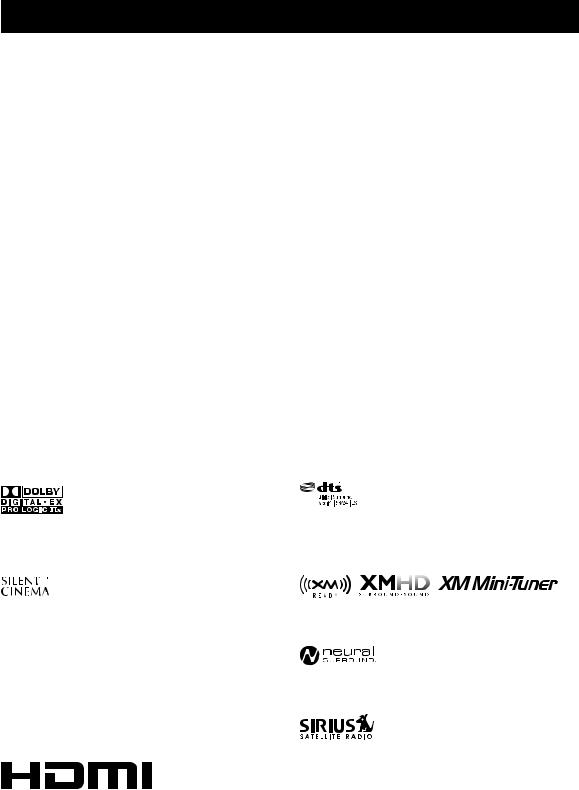
Features
Built-in 7-channel power amplifier
Minimum RMS output power
[U.S.A. and Canada models] (1 kHz, 0.9% THD, 8 Ω)
90 W/ch
[Other models]
(1 kHz, 0.9% THD, 6 Ω) 90 W/ch
SCENE select function
Preset SCENE templates for various situations
SCENE template customizing capability
Decoders and DSP circuits
Proprietary Yamaha technology for the creation of multichannel surround sound
Compressed Music Enhancer mode
Dolby Digital/Dolby Digital EX decoder
DTS/DTS-ES Matrix, Discrete, DTS Neo:6, DTS 96/24 decoder
Dolby Pro Logic/Dolby Pro Logic II/Dolby Pro Logic IIx decoder
Neural Surround decoder (U.S.A. and Canada models only)
Virtual CINEMA DSP
SILENT CINEMA™
Manufactured under license from Dolby Laboratories. “Dolby”, “Pro Logic”, and the double-D symbol are trademarks of Dolby Laboratories.
“SILENT CINEMA” is a trademark of YAMAHA CORPORATION.
iPod™
“iPod” is a trademark of Apple, Inc., registered in the U.S. and other countries.
Bluetooth™
Bluetooth is a registered trademark of the Bluetooth SIG and is used by Yamaha in accordance with a license agreement.
“HDMI”, the “HDMI” logo and “High-Definition Multimedia Interface” are trademarks or registered trademarks of HDMI Licensing LLC.
Radio tuners
FM/AM tuning capability
XM Satellite Radio tuning capability (using XM Mini-Tuner and Home Dock, sold separately)
SIRIUS Satellite Radio™ tuning capability (using SIRIUS Connect tuner, sold separately)
HDMI (High-Definition Multimedia Interface)
HDMI interface for standard, enhanced or high-definition video (includes 1080p video signal transmission) as well as multi-channel digital audio
DOCK terminal
DOCK terminal to connect a Yamaha iPod universal dock (such as YDS-10, sold separately) or Bluetooth adapter (such as YBA-10, sold separately).
Other features
YPAO (Yamaha Parametric Room Acoustic Optimizer) for automatic speaker setup
192-kHz/24-bit D/A converter
DIRECT mode for high quality sound for all sources
6 additional input jacks for discrete multi-channel input
OSD (on-screen display) menus that allow you to optimize this unit to suit your individual audiovisual system
Component video input/output capability
(3 COMPONENT VIDEO INs and 1 MONITOR OUT)
S-video signal input/output capability
Optical and coaxial digital audio signal jacks
Sleep timer
Cinema and music night listening modes
iPod controlling capability
Remote control with preset remote control codes
Zone 2 custom installation facility
Bi-amplification connection capability
DTS-ES | NEO:6 | 96/24. Product “DTS” and “DTS-ES | NEO:6” are registered trademarks of DTS, Inc.
“96/24” is a trademark of DTS, Inc.
The XM name and related logos are registered trademarks of XM Satellite Radio Inc.
Neural Surround™ name and related logos are trademarks owned by Neural Audio Corporation.
©2006 SIRIUS Satellite Radio Inc. “SIRIUS”, “Sirius Connect”, the SIRIUS dog logo, channel names and logos are trademarks of SIRIUS Satellite Radio Inc.
2 En
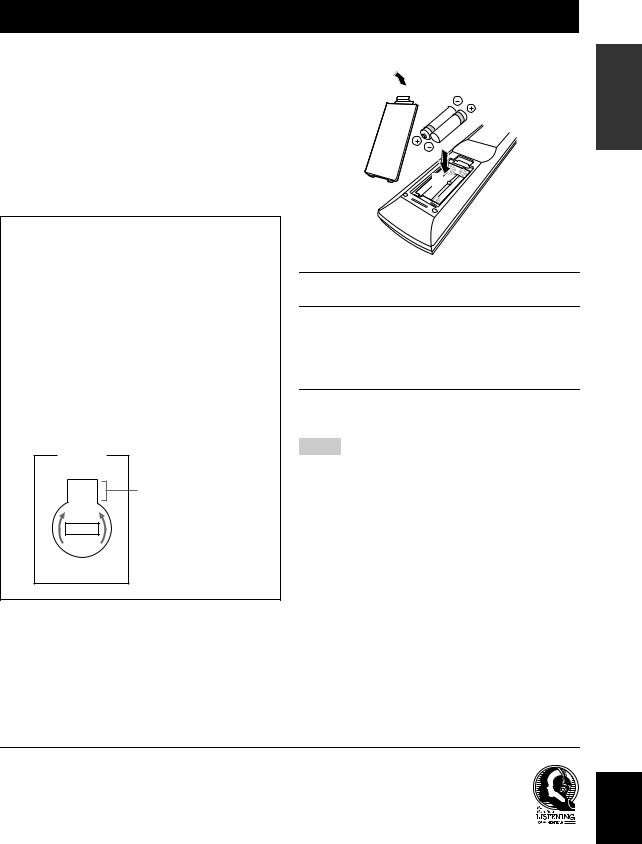
Getting started
■ Supplied accessories
Check that you received all of the following parts.
Remote control
Batteries (2) (AAA, R03, UM-4)
Optimizer microphone
AM loop antenna
Indoor FM antenna
■VOLTAGE SELECTOR
(Asia and General models only)
Caution
The VOLTAGE SELECTOR on the rear panel of this unit must be set for your local voltage BEFORE plugging the power cable into the AC wall outlet. Improper setting of the VOLTAGE SELECTOR may cause damage to this unit and create a potential fire hazard.
Rotate the VOLTAGE SELECTOR clockwise or counterclockwise to the correct position using a straight slot screwdriver.
Voltages are as follows:
Asia model ................... |
220/230–240 V AC, 50/60 Hz |
General model |
|
...................... |
110/120/220/230–240 V AC, 50/60 Hz |
VOLTAGE |
|
SELECTOR |
|
230- |
Voltage indication |
240V |
|
■ Installing batteries in the remote control
1  3
3
2
1Take off the battery compartment cover.
2Insert the two supplied batteries
(AAA, R03, UM-4) according to the polarity markings (+ and –) on the inside of the battery compartment.
3Snap the battery compartment cover back into place.
Notes
•Change all of the batteries if you notice that the operation range of the remote control decreases.
•Do not use an old battery and a new one together.
•Do not use different types of batteries (such as alkaline and manganese batteries) together. Read the packaging carefully as these different types of batteries may have the same shape and color.
•If the batteries have leaked, dispose of them immediately. Avoid touching the leaked material or letting it come into contact with clothing, etc. Clean the battery compartment thoroughly before installing new batteries.
•Do not throw away batteries with general house waste; dispose of them correctly in accordance with your local regulations.
•If the remote control is without batteries for more than 2 minutes, or if exhausted batteries remain in the remote control, the contents of the memory may be cleared. When the memory is cleared, insert new batteries and set up the remote control code.
INTRODUCTION
We Want You Listening For A Lifetime
Yamaha and the Electronic Industries Association’s Consumer |
Since hearing damage from loud sounds is often |
Electronics Group want you to get the most out of your |
undetectable until it is too late, Yamaha and the |
equipment by playing it at a safe level. One that lets the sound |
Electronic Industries Association’s Consumer |
come through loud and clear without annoying blaring or |
Electronics Group recommend you to avoid |
distortion – and, most importantly, without affecting your |
prolonged exposure from excessive volume levels. |
sensitive hearing. |
|
English
3 En
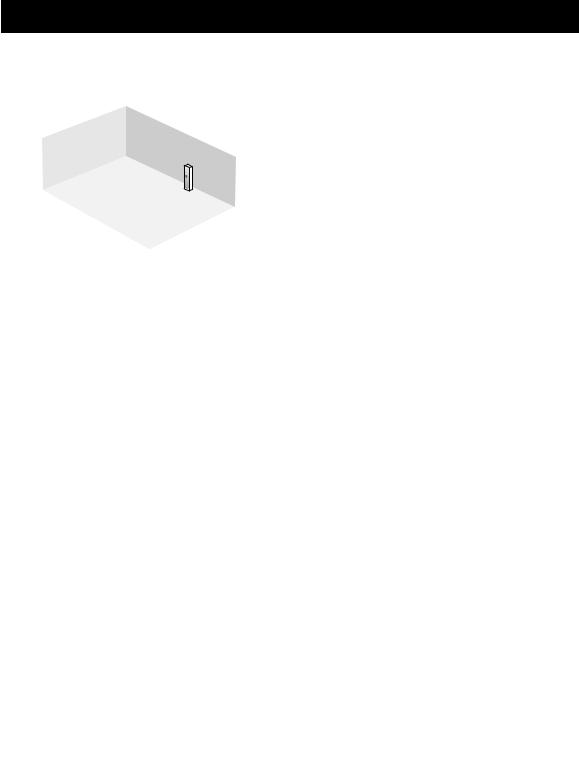
Quick start guide
The following steps describe the easiest way to enjoy DVD movie playback in your home theater.
|
Front right |
Video monitor |
speaker |
|
Subwoofer |
Front left |
Surround right |
speaker |
|
|
speaker |
Center speaker
Surround back right speaker
DVD player
Surround back left speaker
Surround left speaker
Step 1: Set up your speakers
P. 5
Step 2: Connect your DVD player and other components
P. 6
Preparation: Check the items
Prepare the following items. |
|
Speakers |
|
Front speaker ..................................... |
x 2 |
Center speaker ................................... |
x 1 |
Surround speaker .............................. |
x 4 |
Select magnetically shielded speakers. The minimum required speakers are two front speakers. The priority of the requirement of other speakers is as follows:
1. Two surround speakers
2. Center speaker
3. One (or two) surround back speaker(s)
Active subwoofer ................................... |
x 1 |
Select an active subwoofer equipped with an RCA |
|
input jack. |
|
Speaker cable ......................................... |
x 7 |
Subwoofer cable ..................................... |
x 1 |
Select a monaural RCA cable. |
|
DVD player .............................................. |
x 1 |
Select DVD player equipped with coaxial digital |
|
audio output jack and composite video output |
|
jack. |
|
Video monitor .......................................... |
x 1 |
Select a TV monitor, video monitor or projector equipped with a composite video input jack.
Video cable ............................................. |
x 2 |
Select an RCA composite video cable. |
|
Digital coaxial audio cable .................... |
x 1 |
Step 3: Press SCENE 1 button
P. 7
Enjoy DVD playback!
4 En
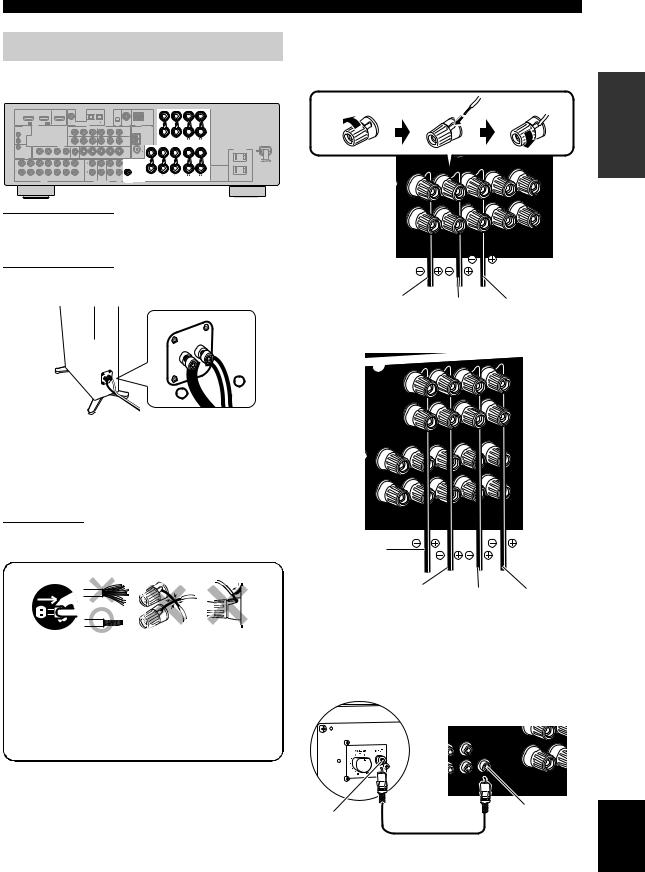
Step 1: Set up your speakers
Place your speakers in the room and connect them to this unit.
SPEAKERS
|
|
|
COAXIAL |
|
|
OPTICAL |
|
|
|
|
|
|
|
|
|
|
DVD |
|
DTV/CBL |
CD |
|
|
|
|
|
|
|
DVD IN1 |
DTV/CBL IN2 |
OUT |
1 |
|
|
2 |
3 |
|
|
|
|
|
|
|
HDMI |
|
|
DIGITAL INPUT |
|
|
XM |
SIRIUS |
DOCK |
|
|
|
|
REMOTE |
|
|
DVD |
|
COMPONENT VIDEO |
|
DTV/CBL |
ANTENNA |
|
|
|
||
|
|
|
|
P |
P |
Y |
P |
P |
Y |
|
|
|
|
IN |
|
|
|
|
|
|
|
|
|
|
|
|
|
|
|
|
|
|
|
|
|
|
DVR |
AM |
|
|
|
|
|
|
|
|
|
|
|
|
|
|
SURROUND BACK/BI-AMP |
R SURROUND L |
|
OUT |
|
|
|
|
|
|
|
|
|
GND |
R |
L |
|
|
|
|
|
|
|
|
|
|
|
|
|
SINGLE |
|
+12V |
|
VIDEO |
|
MONITOR OUT |
|
|
|
|
|
|
|
|
|
15mA MAX. |
VIDEO |
|
|
|
|
|
|
|
|
FM |
|
|
|
AC OUTLETS
|
|
|
|
|
|
|
|
|
|
|
|
|
75 |
|
SWITCHED |
|
|
|
|
|
|
|
|
|
|
|
|
|
UNBAL. |
|
|
TRIGGER |
DVD |
DTV/CBL |
IN |
DVR |
OUT |
MONITOR |
DVD DTV/CBL |
IN |
DVR |
OUT |
MONITOR S VIDEO |
|
|
||
|
OUT |
|
|
OUT |
|
|
OUT |
|
|
||||||
L |
|
|
|
|
|
|
|
L |
|
|
|
|
|
|
|
|
|
|
|
|
|
|
|
|
|
|
CENTER |
|
|
|
|
R |
|
|
|
|
|
|
|
R |
|
|
|
|
SUB |
|
|
|
|
|
|
|
|
|
|
|
|
|
WOOFER |
|
|
||
IN |
MD/ OUT |
|
|
IN |
|
OUT |
|
FRONT(6CH) |
SURROUND |
|
SUB |
CENTER |
R FRONT A L |
R FRONT B L |
|
|
|
|
|
SB(8CH) |
WOOFER |
|
|
|
|||||||
(PLAY) |
CD-R (REC) |
DVD |
DTV/CBL |
|
DVR |
|
CD |
|
|
|
|
|
ZONE 2 |
|
|
|
|
AUDIO |
|
|
|
|
MULTI CH INPUT |
OUT OUTPUT |
|
|
|||||
1Place your speakers and subwoofer in the room.
2Connect speaker cables to each speaker.
Quick start guide
Be sure to connect the left channel (L), right channel (R), “+” (red) and “–” (black) properly.
Front and center speakers
Loosen |
Insert |
Tighten |
To the center speaker
To the front |
To the front |
right speaker |
left speaker |
Surround and surround back speakers
INTRODUCTION
Cables are colored or shaped differently, perhaps with a stripe, groove or ridge. Connect the striped (grooved, etc.) cable to the “+” (red) terminals of your speaker. Connect the plain cable to the “–” (black) terminals.
3 Connect each speaker cable to the
To the surround
corresponding speaker terminal of this unit. back right
speaker
|
1 |
2 |
3 |
4 |
|
|
|
|
|
|
|
|
|
To the surround |
To the surround |
To the surround |
|
|
|
|
|
|
back left speaker |
right speaker |
left speaker |
|
1 |
Make sure that this unit and the subwoofer are |
4 Connect the subwoofer cable to the input |
||||||
jack of the subwoofer and the SUBWOOFER |
||||||||
|
unplugged from the AC wall outlets. |
|||||||
|
OUTPUT jack of this unit. |
|
||||||
2 |
Twist the exposed wires of the speaker cables |
|
||||||
|
|
|
||||||
|
together to prevent short circuits. |
|
Subwoofer |
|
|
|||
|
|
|
|
|
||||
3 |
Do not let the bare speaker wires touch each other. |
|
AV receiver |
|||||
4 |
Do not let the bare speaker wires touch any metal |
|
|
|
||||
|
part of this unit. |
|
|
|
|
|
||
Input jack |
SUBWOOFER |
|
OUTPUT jack |
||
|
||
|
Subwoofer cable |
English
5 En
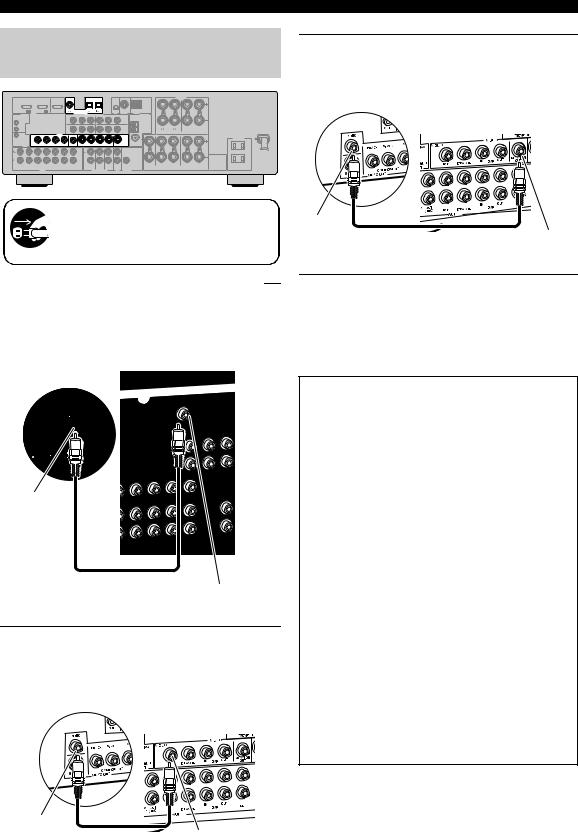
Quick start guide
Step 2: Connect your DVD player and other components
|
|
|
|
|
|
|
|
|
|
|
|
SPEAKERS |
|
|
|
|
COAXIALI |
|
|
OPTICALI |
|
|
|
|
|
|
|
|
|
|
DVD |
|
DTV/CBL/ |
CD |
|
|
|
|
|
|
|
DVD IN1 |
DTV/CBL IN2 |
OUT |
1 |
|
|
2 |
3 |
|
|
|
|
|
|
|
HDMI |
|
|
DIGITAL INPUT |
|
|
XM |
SIRIUS |
DOCK |
|
|
|
|
REMOTE |
|
|
DVD |
|
COMPONENT VIDEO |
|
DTV/CBL |
ANTENNA |
|
|
|
||
|
|
|
|
P |
P |
Y |
P |
P |
Y |
|
|
|
|
IN |
|
|
|
|
|
|
|
|
|
|
|
|
|
|
|
|
|
|
|
|
|
|
DVR |
AM |
|
|
|
|
|
|
|
|
|
|
|
|
|
SURROUND BACK/BI-AMP |
R SURROUND L |
||
OUT |
|
|
|
|
|
|
|
|
|
GND |
R |
L |
|
|
|
|
|
|
|
|
|
|
|
|
|
SINGLE |
|
+12V |
|
VIDEOVIDEO |
|
MONITOR OUT |
|
|
|
|
|
|
|
|
|
VIDEO |
|
|
|
|
|
|
|
FM |
|
|
|
||
15mA MAX. |
|
|
|
|
|
|
|
|
|
|
|||
AC OUTLETS
|
|
|
|
|
|
|
|
|
|
|
|
|
|
75 |
|
SWITCHED |
|
|
|
|
|
|
|
|
|
|
|
|
|
|
UNBAL. |
|
|
TRIGGER |
DVD |
DTV/CBL |
IN |
DVR |
OUT |
MONITORI |
DVD DTV/CBL/ |
ININ |
DVR |
OUT |
MONITORI |
SVIDEOI |
|
|
||
|
OUT |
|
|
OUT |
|
|
OUT |
|
|
|
||||||
L |
|
|
|
|
|
|
|
L |
|
|
|
|
|
|
|
|
|
|
|
|
|
|
|
|
|
|
|
CENTER |
|
|
|
|
|
R |
|
|
|
|
|
|
|
R |
|
|
|
|
|
SUB |
|
|
|
|
|
|
|
|
|
|
|
|
|
|
WOOFER |
|
|
||
IN |
MD/ OUT |
|
|
IN |
|
OUT |
|
FRONT(6CH) |
SURROUND |
|
SUB |
|
CENTER |
R FRONT A L |
R FRONT B L |
|
|
|
|
|
SB(8CH) |
WOOFER |
|
|
|
|
|||||||
(PLAY) |
CD-R (REC) |
DVD |
DTV/CBL |
|
DVR |
|
CD |
|
|
|
|
|
ZONE 2 |
|
|
|
|
|
AUDIO |
|
|
|
|
MULTI CH INPUT |
OUT |
OUTPUT |
|
|
|||||
Make sure that this unit and the DVD player are unplugged from the AC wall outlets.
1Connect the digital coaxial audio cable to the digital coaxial audio output jack of your DVD player and the DVD DIGITAL INPUT COAXIAL jack of this unit.
DVD player |
AV receiver |
Digital coaxial audio output jack
Digital coaxial audio
cable DVD DIGITAL INPUT COAXIAL jack
2Connect the video cable to the composite video output jack of your DVD player and the DVD VIDEO jack of this unit.
DVD player |
AV receiver |
|
Composite video |
|
|
output jack |
Video cable |
DVD VIDEO jack |
|
|
3Connect the video cable to the video input jack of your video monitor and the VIDEO MONITOR OUT jack of this unit.
Video monitor |
AV receiver |
Video input jack
Video cable |
VIDEO MONITOR OUT |
|
jack |
4Connect the power plug of this unit and other components into the AC wall outlet.
y
This unit is equipped with AC OUTLET(S) for the power supply of the other components (except Korea model). See page 22 for details.
■ |
For further connections |
|
• Using the other kind of speaker |
|
|
|
combinations |
P. 11 |
• |
Connecting video components |
P. 16 |
• Connecting a DVD player |
P. 17 |
|
• Connecting a DVD recorder |
P. 18 |
|
• Connecting a set-top box |
P. 18 |
|
• Connecting a CD player |
|
|
|
and a CD recorder/ MD recorder |
P. 19 |
• Connecting a multi-format player |
|
|
|
or an external decoder |
P. 19 |
•Connecting a Yamaha iPod/Bluetooth dock
P. 20
•Connecting the REMOTE IN/OUT jacks
P. 20
•Using the VIDEO AUX jacks on the front
|
panel |
P. 21 |
• |
Connecting an FM/AM antenna |
P. 21 |
• |
Connecting the XM Mini-Tuner Dock |
|
|
|
P. 48 |
•Connecting the SIRIUS Connect tuner
P. 53
6 En
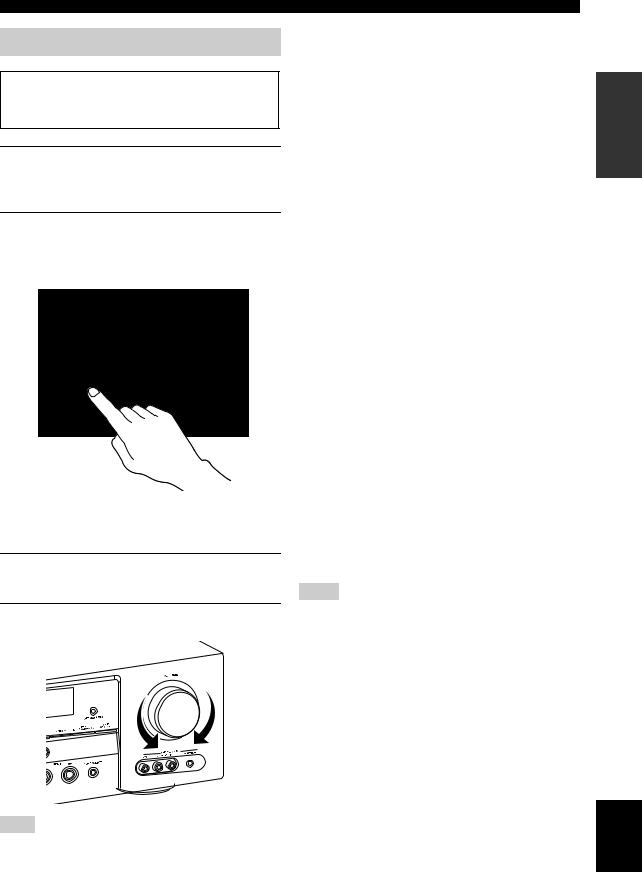
Step 3: Press SCENE 1 button
Check the type of the connected speakers.
If the speakers are 6 ohm speakers, set “SP IMP.” to “6Ω MIN” before using this unit (see page 23).
1Turn on the video monitor and then set the input source selector of the video monitor to this unit.
2Press TSCENE 1.
This unit is turned on. “DVD Viewing” appears in the front panel display, and this unit automatically optimize own status for the DVD playback.
y
The indicator on the selected SCENE button lights up while this unit is in the SCENE mode.
3Start playback of the desired DVD on your player.
4Rotate L VOLUME to adjust the volume.
Quick start guide
■ About SCENE function
Just by pressing one SCENE button, you can turn on this unit and recall your favorite input source and sound field program according to the SCENE template that has been assigned to the SCENE button. The SCENE templates are built combinations of input sources and sound field programs.
y
If you connect a Yamaha product that has capability of the SCENE control signals, this unit can automatically activate the component and start playback. Refer to the instruction manual of the DVD player for further information.
■ Using the other SCENE buttons
Default |
The name of the SCENE template |
SCENE |
and its description |
button |
|
|
|
SCENE |
DVD Viewing |
1 |
– input source: DVD |
|
– sound field program: STRAIGHT |
|
For when you want to enjoy a DVD playback. |
|
|
SCENE |
Disc Listening |
2 |
– input source: DVD |
|
– sound field program: 7ch Stereo |
|
For when you want to listen to a music disc from |
|
the connected DVD player as the background |
|
music for this room. |
|
|
SCENE |
TV Viewing *1 |
3 |
– input source: DTV/CBL |
|
|
|
– sound field program: STRAIGHT |
|
For when you want to watch a TV program. |
|
|
SCENE |
Radio Listening *2, *3, *4 |
4 |
– input source: TUNER |
|
|
|
– sound field program: 7ch Enhancer |
|
For when you want to listen to a music program |
|
from the FM radio station. |
|
|
Notes
*1 You must connect a cable TV or a satellite tuner to this unit in advance. See page 18 for details.
*2 You need to connect the supplied FM and AM antennas to this unit in advance. See page 21 for details.
*3 You must tune into the desired radio station. See pages 45 to 47 for the tuning information.
*4 To achieve the best possible reception, orient the connected AM loop antenna, or adjust the position of the end of the indoor FM antenna.
y
If you cannot find the desired situation, you can select and change the assigned SCENE template for the SCENE buttons. See
page 30 for details.
INTRODUCTION
Note
When you change the input source or sound field program, the SCENE mode is deactivated, and the indicator on the selected SCENE button turns off.
English
7 En
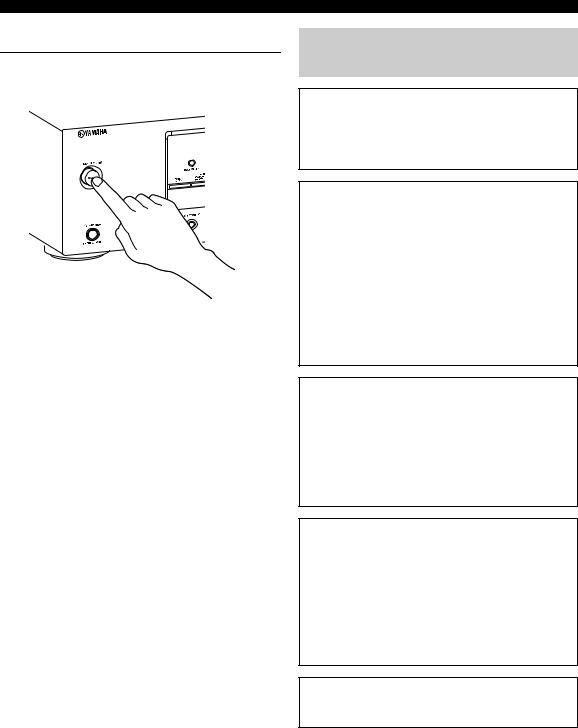
Quick start guide
■ After using this unit...
Press AMAIN ZONE ON/OFF on the front panel to set this unit to the standby mode.
This unit is set to the standby mode. In the standby mode, this unit consumes a small amount of power in order to receive infrared signals from the remote control. To turn on this unit from the standby mode, press AMAIN ZONE ON/OFF (or HPOWER). See page 23 for details.
What do you want to do with this unit?
■ Customizing the SCENE templates
• Using various SCENE templates P. 30
•Creating your original SCENE templates
P. 33
■ Using various input sources
• |
Basic controls of this unit |
P. 35 |
• |
Enjoying FM/AM radio programs |
P. 45 |
•Enjoying XM Satellite Radio programs
P. 48
•Enjoying SIRIUS Satellite Radio programs
P. 53
• |
Using your iPod with this unit |
P. 59 |
• |
Using your Bluetooth components |
|
|
with this unit |
P. 61 |
■ Using various sound features
•Using various sound field programs
P. 40
•Using the direct mode for
the high quality sound |
P. 43 |
•Customizing the sound field programs
P. 42
■ Adjusting the parameters of this unit
• Automatically optimizing the speaker parameters for your listening room (AUTO
SETUP) |
P. 26 |
• Manually adjusting various parameters of
|
this unit |
P. 63 |
• |
Setting the remote control |
P. 76 |
• |
Adjusting the advanced parameters P. 82 |
|
■ Additional features
Automatically turning off this unit |
P. 39 |
8 En
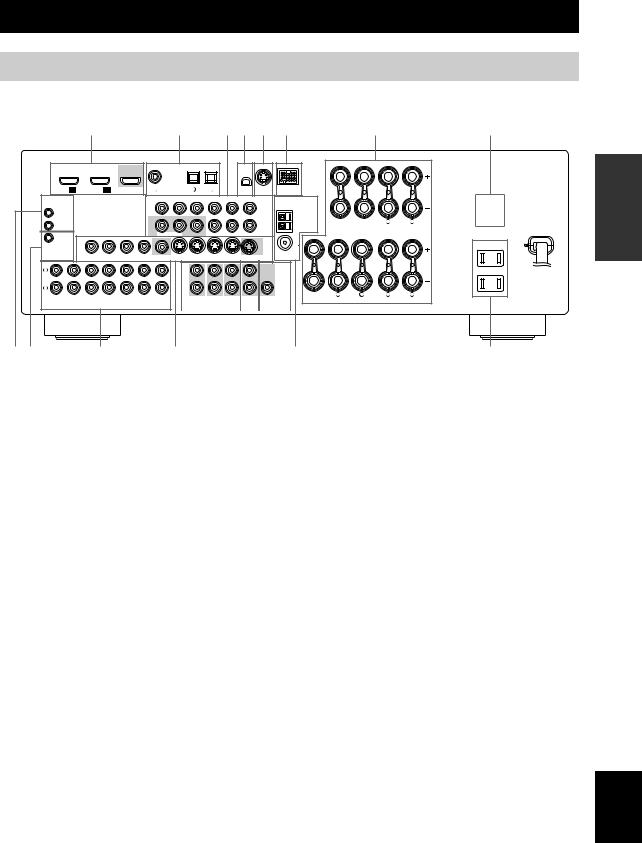
Connections
Rear panel
1 |
2 |
3 4 5 6 |
7 |
8 |
|
|
|
|
|
|
|
|
|
|
|
|
|
|
SPEAKERS |
|
|
|
|
|
|
COAXIAL |
|
|
OPTICAL |
|
|
|
|
|
|
|
|
|
|
|
|
|
|
|
|
|
|
|
|
|
|
|
|
|
|
|
|
DVD |
|
DTV/CBL |
CD |
|
|
|
|
|
|
|
DVD |
IN1 |
DTV/CBL |
IN2 |
OUT |
1 |
|
|
2 |
3 |
|
|
|
|
|
|
|
|
HDMI |
|
|
|
DIGITAL INPUT |
|
|
XM |
SIRIUS |
DOCK |
|
|
|
|
REMOTE |
|
|
|
DVD |
|
COMPONENT VIDEO |
|
DTV/CBL |
ANTENNA |
|
|
|
|||
|
|
|
|
|
|
PR |
PB |
Y |
PR |
PB |
Y |
|
|
|
|
IN |
|
|
|
|
|
|
|
|
|
|
|
|
|
|
|
|
|
|
|
|
|
|
|
|
|
|
DVR |
AM |
|
|
|
|
|
|
|
|
|
|
|
|
|
|
|
SURROUND BACK/BI-AMP |
R SURROUND L |
||
OUT |
|
|
|
|
|
|
|
|
|
|
|
GND |
|||
|
|
|
|
|
|
|
|
|
|
|
R |
L |
|
||
SINGLE
+12V |
|
|
|
|
VIDEO |
MONITOR OUT |
|
|
|
|
|
|
|
|||
VIDEO |
|
|
|
|
|
|
|
|
|
FM |
|
|
||||
15mA MAX. |
|
|
|
|
|
|
|
|
|
|
|
|
AC OUTLETS |
|||
|
|
|
|
|
|
|
|
|
|
|
|
|
|
75 |
|
|
|
|
|
|
|
|
|
|
|
|
|
|
|
|
|
SWITCHED |
|
|
|
|
|
|
|
|
|
|
|
|
|
|
|
UNBAL. |
|
|
TRIGGER |
|
DVD |
DTV/CBL |
IN |
DVR |
OUT |
MONITOR |
DVD DTV/CBL |
IN |
DVR |
OUT |
MONITOR S VIDEO |
|
|
||
|
OUT |
|
|
|
OUT |
|
|
OUT |
|
|
||||||
L |
|
|
|
|
|
|
|
|
L |
|
|
|
|
|
|
|
|
|
|
|
|
|
|
|
|
|
|
|
CENTER |
|
|
|
|
R |
|
|
|
|
|
|
|
|
R |
|
|
|
|
SUB |
|
|
|
|
|
|
|
|
|
|
|
|
|
|
|
|
WOOFER |
|
|
|
|
|
|
|
|
|
|
|
FRONT(6CH) |
|
|
|
SUB |
CENTER |
R FRONT A L |
R FRONT B L |
IN |
MD/ OUT |
|
|
IN |
|
OUT |
|
|
|
|
|
|
|
|||
(PLAY) |
CD-R (REC) |
DVD |
DTV/CBL |
|
DVR |
|
CD |
SB(8CH) |
SURROUND |
WOOFER |
ZONE 2 |
|
|
|||
|
|
|
|
|
|
|
|
|
||||||||
|
|
|
AUDIO |
|
|
|
|
MULTI CH INPUT |
OUT OUTPUT |
|
|
|||||
|
|
|
|
|
|
|
|
|
|
|
|
|
90 |
A |
B |
|
|
|
|
|
|
|
G (U.S.A. model) |
||
C |
D E F |
|||||||||||
|
|
|
|
|
|
|
|
|
||||
|
|
Name |
|
|
|
|
Page |
|
|
|
||
|
|
|
|
|
|
|
|
|
|
|
|
|
1 |
HDMI jacks |
|
|
|
|
|
14 |
|
|
|
|
|
|
|
|
|
|
|
|
|
|
|
|
||
2 |
DIGITAL INPUT jacks |
|
|
|
|
13 |
|
|
|
|
||
|
|
|
|
|
|
|
|
|
|
|
||
3 |
COMPONENT VIDEO jacks |
|
|
|
|
13 |
|
|
|
|
||
|
|
|
|
|
|
|
||||||
4 |
XM jack (U.S.A. and Canada models only) |
48 |
|
|
|
|
||||||
|
|
|
|
|
|
|
|
|
|
|
|
|
5 |
SIRIUS jack |
|
|
|
|
|
53 |
|
|
|
|
|
|
(U.S.A. and Canada models only) |
|
|
|
|
|
|
|
|
|||
|
|
|
|
|
|
|
|
|
|
|
||
6 |
DOCK terminal |
|
|
|
|
20 |
|
|
|
|
||
|
|
|
|
|
|
|
|
|
|
|
||
7 |
Speaker terminals |
|
|
|
|
11 |
|
|
|
|
||
|
|
|
|
|
|
|
|
|
|
|
||
8 |
VOLTAGE SELECTOR |
|
|
|
|
3 |
|
|
|
|
||
|
(Asia and General models only) |
|
|
|
|
|
|
|
|
|||
|
|
|
|
|
|
|
|
|
|
|
||
9 |
REMOTE IN/OUT jacks |
|
|
|
|
20 |
|
|
|
|
||
|
|
|
|
|
|
|
|
|
|
|||
0 |
TRIGGER OUT jack |
|
|
|
|
|
— |
|
||||
|
This is a control expansion jack for custom |
|
|
|
|
|
|
|||||
|
installation. |
|
|
|
|
|
|
|
|
|
|
|
|
|
|
|
|
|
|
|
|
|
|
|
|
A |
AUDIO jacks |
|
|
|
|
|
13 |
|
|
|
|
|
|
|
|
|
|
|
|
|
|
|
|
|
|
B |
VIDEO jacks |
|
|
|
|
|
13 |
|
|
|
|
|
|
|
|
|
|
|
|
|
|
|
|||
C MULTI CH INPUT jacks |
|
|
|
|
19 |
|
|
|
|
|||
|
|
|
|
|
|
|
|
|
|
|||
D ZONE 2 OUT jacks |
|
|
|
|
79 |
|
|
|
|
|||
|
|
|
|
|
|
|
|
|
|
|
||
E |
SUBWOOFER OUTPUT jack |
|
|
|
|
11 |
|
|
|
|
||
|
|
|
|
|
|
|
|
|
|
|
||
F |
ANTENNA terminals |
|
|
|
|
21 |
|
|
|
|
||
|
|
|
|
|
|
|
|
|
|
|
||
G |
AC OUTLET(S) |
|
|
|
|
22 |
|
|
|
|
||
|
|
|
|
|
|
|
|
|
|
|
|
|
PREPARATION
English
9 En
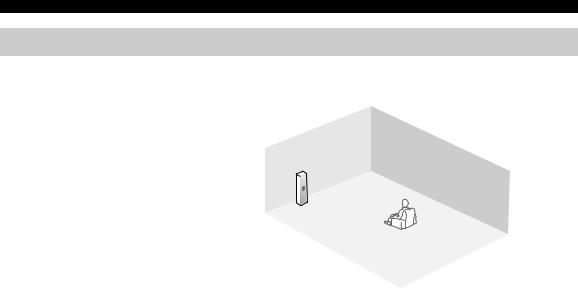
Connections
Placing speakers
The speaker layout below shows the speaker setting we recommend. You can use it to enjoy CINEMA DSP and multichannel audio sources.
|
|
C |
|
|
FL |
|
|
FR |
FR |
|
|
|
|
|
|
|
|
FL |
SW |
|
|
30˚ |
SR |
|
|
|
|
|
C |
SL |
|
60˚ |
SR |
SL |
|
|
|
SBR |
|
SL |
80˚ |
|
SR |
|
|
|
|||
|
SBL |
SBR |
|
SBL |
30 cm (12 in) or more |
|
|
||
Front left and right speakers (FL and FR)
The front speakers are used for the main source sound plus effect sounds. Place these speakers at an equal distance from the ideal listening position. The distance of each speaker from each side of the video monitor should be the same.
Center speaker (C)
The center speaker is for the center channel sounds (dialog, vocals, etc.). If for some reason it is not practical to use a center speaker, you can do without it. Best results, however, are obtained with the full system.
Surround left and right speakers (SL and SR)
The surround speakers are used for effect and surround sounds.
Surround back left and right speakers (SBL and SBR)
The surround back speakers supplement the surround speakers and provide more realistic front-to-back transitions.
Subwoofer (SW)
The use of a subwoofer with a built-in amplifier, such as the Yamaha Active Servo Processing Subwoofer System, is effective not only for reinforcing bass frequencies from any or all channels, but also for high fidelity sound reproduction of the LFE (low-frequency effect) channel included in Dolby Digital and DTS sources. The position of the subwoofer is not so critical, because low bass sounds are not highly directional. But it is better to place the subwoofer near the front speakers. Turn it slightly toward the center of the room to reduce wall reflections.
10 En
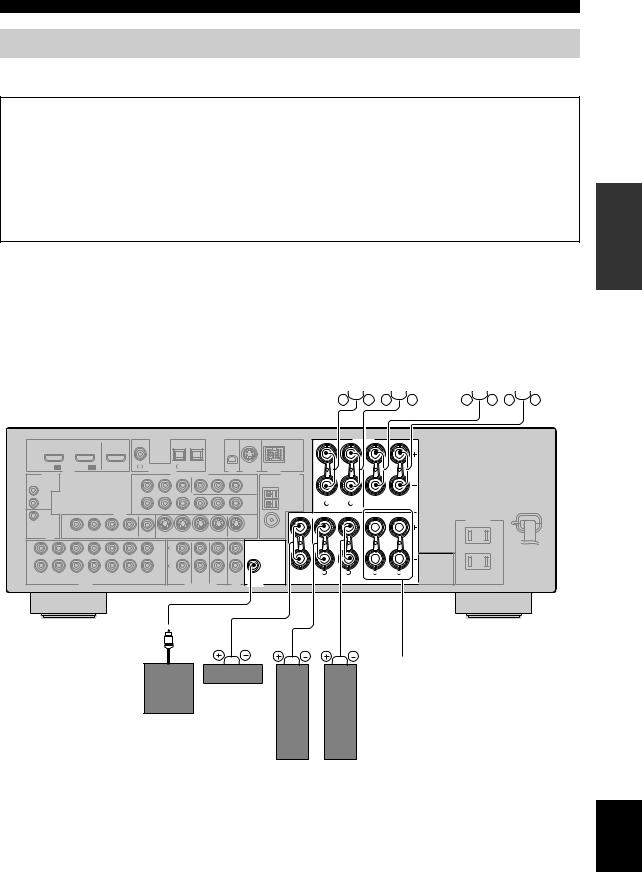
Connections
Connecting speakers
Be sure to connect the left channel (L), right channel (R), “+” (red) and “–” (black) properly. If the connections are faulty, this unit cannot reproduce the input sources accurately.
Caution
•Before connecting the speakers, make sure that the AC power plug is disconnected from the AC wall outlet.
•Do not let the bare speaker wires touch each other or let them touch any metal part of this unit. This could damage this unit and/or the speakers. If the speaker wires are short-circuited, “CHECK SP WIRES” appears in the front panel display when you turn on this unit.
•Use the magnetically shielded speakers. If this type of speaker still creates interference with the monitor, place the speakers away from the monitor.
•If you are to use 6 ohm speakers, be sure to set “SP IMP.” to “6Ω MIN” before using this unit. For details about the speaker impedance setting, see page 23.
When you use single surround back speaker, connect the speaker to the left SURROUND BACK terminal (SINGLE).
Surround back speakers |
Surround speakers |
||||||||||||
|
Right |
Left |
|
Right |
Left |
||||||||
|
|
|
|
|
|
|
|
|
|
|
|
|
|
|
|
|
|
|
|
|
|
|
|
|
|
|
|
|
|
|
|
|
|
|
|
|
|
|
|
|
|
PREPARATION
SPEAKERS
COAXIAL
|
|
|
|
OPTICAL |
|
|
|
|
|
|
DVD |
DTV/CBL |
CD |
|
|
DVD IN1 |
DTV/CBL IN2 |
OUT |
1 |
2 |
3 |
|
|
|
HDMI |
|
|
DIGITAL INPUT |
XM |
SIRIUS |
DOCK |
REMOTE |
|
|
|
|
|
|
DVD |
|
COMPONENT VIDEO |
|
|
|
DTV/CBL |
ANTENNA |
|
|
|
|
|||||
|
|
|
|
|
|
|
|
|
PR |
|
PB |
Y |
|
PR |
|
PB |
|
Y |
|
|
|
|
|
IN |
|
|
|
|
|
|
|
|
|
|
|
|
|
|
|
|
|
|
|
|
|
|
|
|
|
|
|
|
|
|
|
|
|
|
|
|
|
|
|
|
|
DVR |
AM |
|
|
|
|
|
|
|
|
|
|
|
|
|
|
|
|
|
|
|
|
|
|
|
SURROUND BACK/BI-AMP |
R SURROUND L |
|||
OUT |
|
|
|
|
|
|
|
|
|
|
|
|
|
|
|
|
|
GND |
|||||
|
|
|
|
|
|
|
|
|
|
|
|
|
|
|
|
|
R |
L |
|
|
|||
|
|
|
|
|
|
|
|
|
|
|
|
|
|
|
|
|
|
|
|
|
SINGLE |
|
|
+12V |
|
|
|
|
|
VIDEO |
MONITOR OUT |
|
|
|
|
|
|
|
|
|
|
|
|
|
|||
|
VIDEO |
|
|
|
|
|
|
|
|
|
|
|
|
|
FM |
|
|
|
|
||||
15mA MAX. |
|
|
|
|
|
|
|
|
|
|
|
|
|
|
|
|
|
|
AC OUTLETS |
||||
|
|
|
|
|
|
|
|
|
|
|
|
|
|
|
|
|
|
|
75 |
|
|
|
|
|
|
|
|
|
|
|
|
|
|
|
|
|
|
|
|
|
|
|
|
|
|
SWITCHED |
|
|
|
|
|
|
|
|
|
|
|
|
|
|
|
|
|
|
|
|
UNBAL. |
|
|
|
|
TRIGGER |
|
DVD |
DTV/CBL |
IN |
DVR |
OUT |
MONITOR |
DVD |
|
DTV/CBL |
IN |
DVR |
OUT |
MONITOR S VIDEO |
|
|
|
|
|
||||
|
OUT |
|
|
|
|
OUT |
|
|
|
OUT |
|
|
|
|
|
|
|||||||
L |
|
|
|
|
|
|
|
|
|
|
L |
|
|
|
|
|
|
|
|
|
|
|
|
|
|
|
|
|
|
|
|
|
|
|
|
|
|
|
CENTER |
|
|
|
|
|
|
|
|
R |
|
|
|
|
|
|
|
|
|
|
R |
|
|
|
|
|
|
SUB |
|
|
|
|
|
|
|
|
|
|
|
|
|
|
|
|
|
|
|
|
|
|
|
WOOFER |
|
|
|
|
|
|
|
|
|
|
|
|
|
|
|
|
FRONT(6CH) |
|
|
|
SUB |
|
|
CENTER |
R FRONT A |
L |
R FRONT B |
L |
|
IN |
MD/ |
OUT |
|
|
IN |
|
OUT |
|
|
|
|
|
|
|
|
|
|
|
|
||||
(PLAY) |
CD-R (REC) |
DVD |
DTV/CBL |
|
DVR |
|
CD |
|
|
SB(8CH) |
SURROUND |
WOOFER |
ZONE 2 |
|
|
|
|
|
|||||
|
|
|
|
|
|
|
|
|
|
|
|
|
|
||||||||||
|
|
|
|
AUDIO |
|
|
|
|
|
|
MULTI CH INPUT |
OUT |
OUTPUT |
|
|
|
|
|
|||||
FRONT B terminals
Connect the alternative front speaker system
(FRONT B).
Center speaker
Subwoofer
Right Left
Front speakers
(FRONT A)
English
11 En
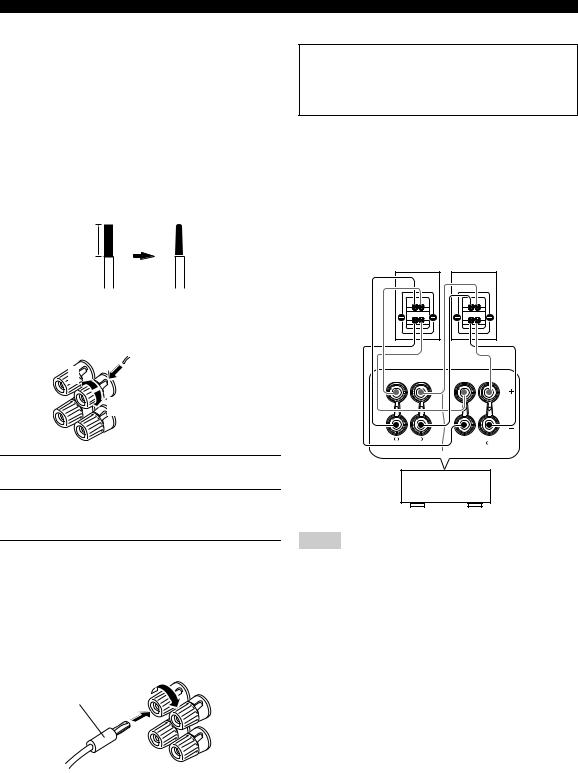
Connections
■ Before connecting to the SPEAKERS terminal
A speaker cord is actually a pair of insulated cables running side by side. Cables are colored or shaped differently, perhaps with a stripe, groove or ridges.
Connect the striped (grooved, etc.) cable to the “+” (red) terminals of this unit and your speaker. Connect the plain cable to the “–” (black) terminals.
Remove approximately 10 mm (3/8”) of insulation from the end of each speaker cable and then twist the bare wires of the cable together to prevent short circuits.
10 mm (3/8”)
■ Connecting to the FRONT A terminals
2 
1 |
Red: positive (+) |
|
|
|
Black: negative (–) |
|
3 |
1Loosen the knob.
2Insert the bare end of the speaker wire into the hole on the terminal.
3Tighten the knob to secure the wire.
Connecting the banana plug
(except Europe, Russia, Korea, and Asia models)
The banana plug is a single-pole electrical connector widely used to terminate speaker cables. First, tighten the knob and then insert the banana plug connector into the end of the corresponding terminal.
Banana plug
■ Using bi-amplification connections
Caution
Remove the shorting bars or bridges to separate the LPF (low pass filter) and HPF (high pass filter) crossovers.
This unit allows you to make bi-amplification connections to one speaker system. Check if your speakers support biamplification.
To make the bi-amplification connections, use the FRONT and SURROUND BACK terminals as shown below. To activate the bi-amplification connections, set “BI-AMP” to “ON” in “Advanced setup” (see page 82).
Front speakers
Right |
Left |
R FRONT A L |
SURROUND BACK/BI-AMP |
R L
SINGLE
This unit
Notes
•When you make the conventional connection, make sure that the shorting bars are put into the terminals appropriately. Refer to the instruction manuals of the speakers for details.
•When you use bi-amplification connections, you can not use surround back speakers.
12 En
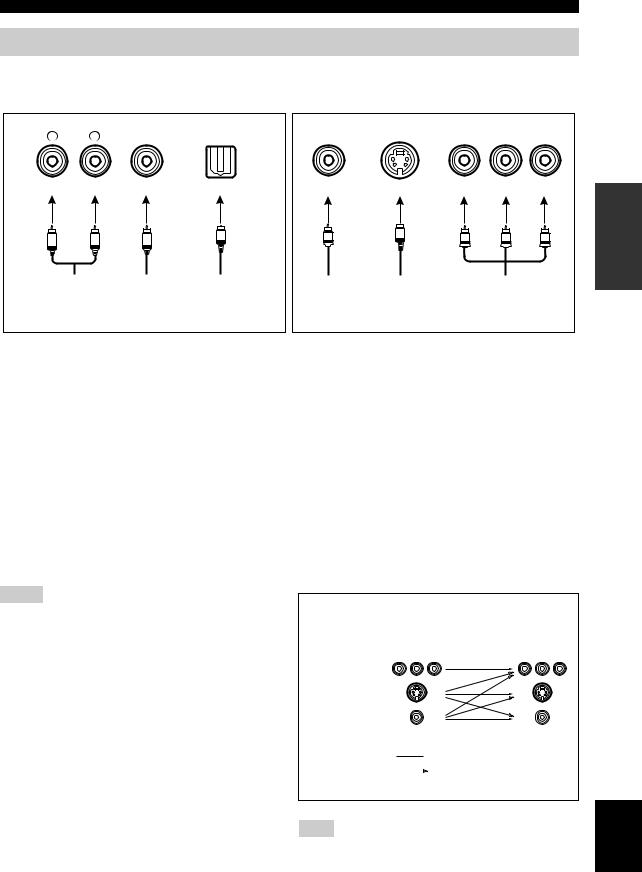
Connections
Information on jacks and cable plugs
Connect one of the type of the audio jack(s) and/or video jack(s) that your input components are equipped with.
Audio jacks and cable plugs |
Video jacks and cable plugs |
AUDIO |
DIGITAL AUDIO |
DIGITAL AUDIO |
|
L |
R |
COAXIAL |
OPTICAL |
(White) |
(Red) |
(Orange) |
|
L |
R |
C |
O |
|
|||
Left and right |
Coaxial |
Optical |
|
analog audio |
digital audio |
digital |
|
cable plugs |
cable plug |
audio cable |
|
|
|
|
plug |
|
|
COMPONENT VIDEO |
||
VIDEO |
S VIDEO |
PR |
PB |
Y |
(Yellow) |
|
(Red) |
(Blue) |
(Green) |
V |
S |
PR |
PB |
Y |
|
||||
Composite |
S-video |
|
Component |
|
video cable |
cable plug |
|
video cable |
|
plug |
|
|
plugs |
|
PREPARATION
■ Audio jacks
This unit has three types of audio jacks. Connection depends on the availability of audio jacks on your other components.
AUDIO jacks
For conventional analog audio signals transmitted via left and right analog audio cables. Connect red plugs to the right jacks and white plugs to the left jacks.
DIGITAL AUDIO COAXIAL jacks
For digital audio signals transmitted via coaxial digital audio cables.
DIGITAL AUDIO OPTICAL jacks
For digital audio signals transmitted via optical digital audio cables.
Notes
•You can use the digital jacks to input PCM, Dolby Digital and DTS bitstreams. Optical input jacks are compatible with digital signals with up to 96 kHz of sampling frequency.
•This unit handles digital and analog signals independently. Thus audio signals input at the digital jacks are not output at the analog AUDIO OUT (REC) jacks.
■ Video jacks
This unit has three types of video jacks. Connection depends on the availability of input jacks on your video monitor.
VIDEO jacks
For conventional composite video signals transmitted via composite video cables.
S VIDEO jacks
For S-video signals, separated into the luminance (Y) and chrominance (C) video signals transmitted on separate wires of S-video cables.
COMPONENT VIDEO jacks
For component signals, separated into the luminance (Y) and chrominance (PB, PR) video signals transmitted on separate wires of component video cables.
Video signal flow for MONITOR OUT |
|
Input |
Output |
(MONITOR OUT) |
|
PR PB Y |
PR PB Y |
COMPONENT
VIDEO
S VIDEO
VIDEO
 Through
Through
 Video conversion ON (see page 73)
Video conversion ON (see page 73)
Note
The OSD signal is not output at the DVR OUT (REC) jacks.
English
13 En
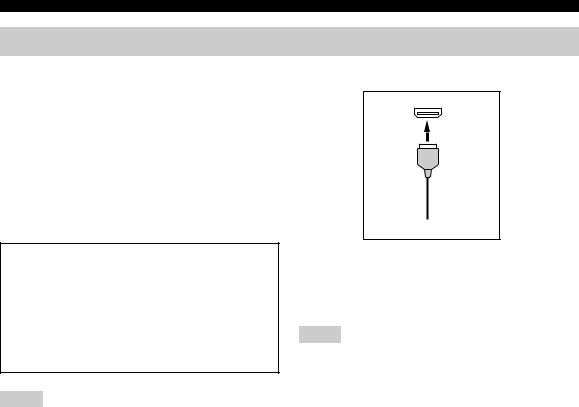
Connections
Information on HDMI™
■ HDMI compatibility with this unit
Audio signal |
Audio signal |
Compatible |
|
HDMI |
|||
types |
formats |
||
components |
|||
|
|
||
|
|
|
|
2ch Linear PCM |
2ch, 32-192 kHz, |
CD, DVD-Video, |
|
|
16/20/24 bit |
DVD-Audio, etc. |
|
|
|
|
|
Multi-ch Linear |
8ch, 32-192 kHz, |
DVD-Audio, etc. |
|
PCM |
16/20/24 bit |
|
|
|
|
|
|
Bitstream |
Dolby Digital, DTS |
DVD-Video, etc. |
|
|
|
|
This unit’s HDMI interface is based on the following standards:
•HDMI Version 1.2a (High-Definition Multimedia Interface Specification Version 1.2a) licensed by HDMI Licensing, LLC.
•HDCP (High-bandwidth Digital Content Protection System) licensed by Digital Content Protection, LLC.
Notes
•When CPPM copy-protected DVD audio is played back, video and audio signals may not be output depending on the type of the DVD player.
•This unit is not compatible with HDCP-incompatible HDMI or DVI components.
•You can check the potential problem about the HDMI connection (see page 38).
■ HDMI jack and cable plug
HDMI
HDMI cable plug
y
•We recommend using an HDMI cable shorter than 5 meters (16 feet) with the HDMI logo printed on it.
•Use a conversion cable (HDMI jack ↔DVI-D jack) to connect this unit to other DVI components.
Notes
•Do not disconnect or connect the cable or turn off the power of the HDMI components connected to the HDMI OUT jack of this unit while data is being transferred. Doing so may disrupt playback or cause noise.
•Audio signals input at input jacks other than the HDMI IN DVD or HDMI IN DTV/CBL jack of this unit cannot be digitally output at the HDMI OUT jack.
•If you turn off the power of the video monitor connected to the HDMI OUT jack via a DVI connection, this unit may fail to establish the connection to the component.
14 En
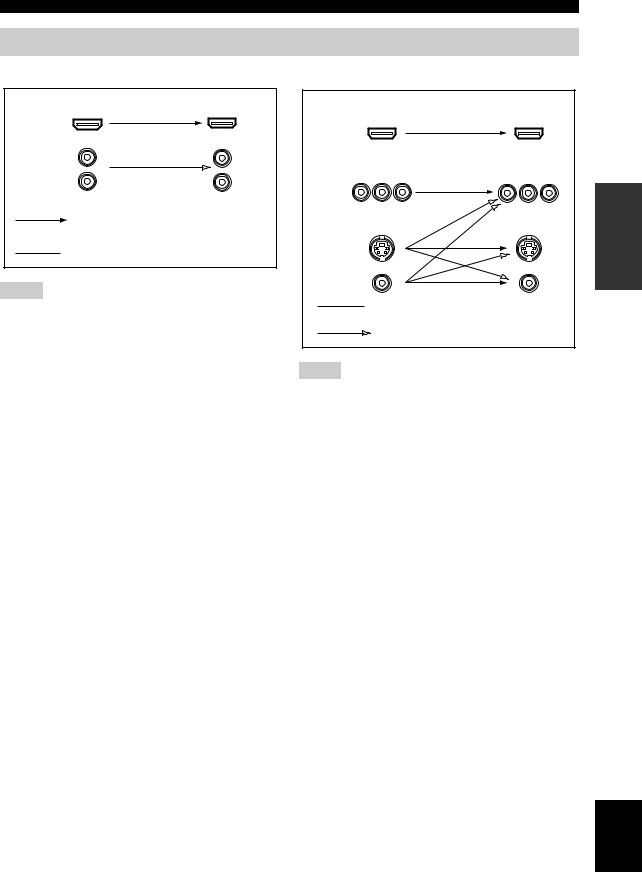
Audio and video signal flow
■ Audio signal flow
Input |
Output |
HDMI
AUDIO
Digital output
 Analog output
Analog output
Notes
•2-channel as well as multi-channel PCM, Dolby Digital and DTS signals input at the HDMI IN DVD or HDMI IN DTV/ CBL jack can be output at the HDMI OUT jack only when “SUPPORT AUDIO” is set to “Other” (see page 70).
•Audio signals input at the HDMI IN jacks are not output at the AUDIO output jacks.
Connections
■ Video signal flow
Input |
Output |
HDMI
COMPONENT
VIDEO
S VIDEO
VIDEO
 Through
Through
 Video conversion ON (see page 73)
Video conversion ON (see page 73)
Notes
•When the all video signals are input at the HDMI, COMPONENT VIDEO, S VIDEO and VIDEO jacks, the priority order of the input signals is as follows:
1.HDMI
2.COMPONENT VIDEO
3.S VIDEO
4.VIDEO
•When some digital video signals are input at the HDMI IN DVD or HDMI IN DTV/CBL jack, the video conversion function does not work.
•Digital video signals input at the HDMI IN DVD or HDMI IN DTV/CBL jack cannot be output from analog video output jacks.
PREPARATION
English
15 En
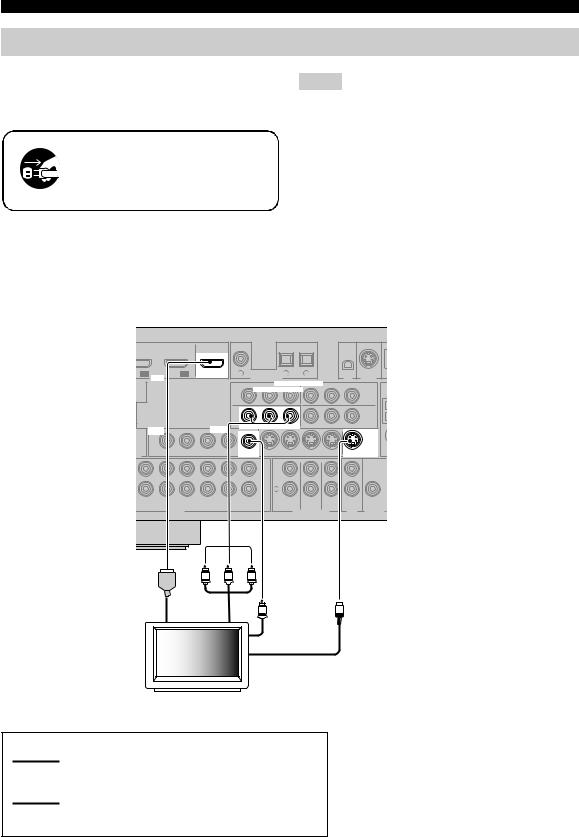
Connections
Connecting video components
Connect your TV (or projector) to the HDMI OUT jack, the COMPONENT VIDEO MONITOR OUT jacks, the S VIDEO MONITOR OUT jack or the VIDEO MONITOR OUT jack of this unit.
Make sure that this unit and other components are unplugged from the AC wall outlets.
y
You can choose to play back HDMI audio signals on this unit or on another HDMI component connected to the HDMI OUT jack of this unit. Use the “SUPPORT AUDIO” parameter in “SOUND MENU” to select the component to play back HDMI audio signals (see page 70).
Notes
•Some video monitors connected to this unit via a DVI connection fail to recognize the HDMI audio/video signals being input if they are in the standby mode. In this case, the HDMI indicator flashes irregularly.
•When you connect your TV monitor or projector via HDMI connection, the OSD does not appear. In such cases, connect the TV monitor or projector via component, S-video or video connection.
•Connect the input source components to the HDMI IN DVD or HDMI IN DTV/CBL jack to display the video images on the video monitor connected to the HDMI OUT jack.
|
|
|
|
COAXIAL |
|
|
OPTICAL |
|
|
|
|
|
|
|
|
|
|
|
|
|
|
|
|
|
|
DVD |
|
DTV/CBL |
CD |
|
|
|
D IN1 |
DTV/CBL |
IN2 |
OUT |
1 |
|
|
2 |
3 |
|
|
|
HDMI |
|
|
|
DIGITAL INPUT |
|
|
XM |
SIRIUS |
|
OTE |
|
|
|
DVD |
|
COMPONENT VIDEO |
|
DTV/CBL |
||
|
|
|
|
|
PR |
PB |
Y |
PR |
PB |
Y |
|
|
|
|
|
|
|
|
|
|
DVR |
|
|
|
|
|
MONITOR OUT |
|
|
|
|
|
MAX. VIDEO |
|
|
|
VIDEO |
|
|
|
|
|
|
|
|
|
|
|
|
|
|
|
|
|
|
|
|
|
GER |
DVD |
DTV/CBL |
IN |
DVR |
OUT |
MONITOR |
DVD DTV/CBL |
IN |
DVR |
OUT |
MONITOR S VIDEO |
|
UT |
|
|
OUT |
|
|
OUT |
||||||
|
|
|
|
|
|
|
L |
|
|
|
|
|
|
|
|
|
|
|
|
|
|
|
CENTER |
|
|
|
|
|
|
|
|
|
R |
|
|
|
|
W |
|
|
|
|
|
|
|
|
|
|
|
|
|
D/ OUT |
|
|
IN |
|
OUT |
|
FRONT(6CH) |
|
|
|
SUB |
|
-R (REC) |
DVD |
DTV/CBL |
|
DVR |
|
CD |
SB(8CH) |
SURROUND |
WOOFER |
ZONE 2 |
||
|
|
|
|
|
|
|
||||||
|
AUDIO |
|
|
|
|
MULTI CH INPUT |
OUT OUTPUT |
|||||
PR PB Y
HDMI in |
Component |
|
|
|
video in |
V |
S |
||
|
||||
|
|
|
||
|
|
|
Video in |
S-video in
TV (or projector)
indicates recommended connections
indicates alternative connections (One for the video connection, and one for the audio connection)
16 En
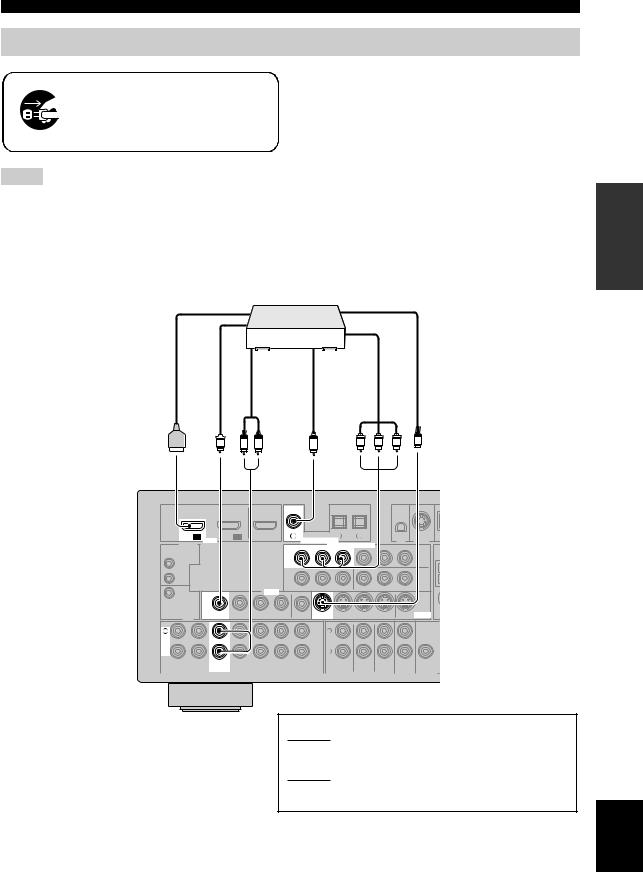
Connecting other components
Make sure that this unit and other components are unplugged from the AC wall outlets.
Notes
•When “VIDEO CONV.” is set to “OFF” (see page 73), be sure to make the same type of video connections as those made for your TV (see page 16). For example, if you connected your TV to the VIDEO MONITOR OUT jack of this unit, connect your other components to the VIDEO jacks.
Connections
•When “VIDEO CONV.” is set to “ON” (see page 73), the converted video signals are output only at the MONITOR OUT jacks. To record a source, make the same type of video connections between each component.
•To make a digital connection to a component other than the default component assigned to DIGITAL INPUT jack, select the corresponding setting for “OPTICAL IN” or “COAXIAL IN” in “INPUT ASSIGNMENT” (see page 71).
•If you connect your DVD player to both the DIGITAL INPUT (OPTICAL) and the DIGITAL INPUT (COAXIAL) jacks, priority is given to the signals input at the DIGITAL INPUT (COAXIAL) jack.
■ Connecting a DVD player
|
DVD player |
S-video out |
|
HDMI out |
|
|
|
out Video |
|
|
Component out video |
out Audio |
out Coaxial |
||
|
|
V |
R |
L |
|
|
C |
|
|
|
PR |
PB |
Y |
S |
|
|
|
|
|
|
|
|
|
||||||||
|
|
|
|
|
|
|
COAXIAL |
|
OPTICAL |
|
|
|
|
|
|
|
|
|
|
|
|
|
|
|
|
|
|
|
|
||
|
|
|
|
|
|
|
DVD |
|
DTV/CBL |
|
CD |
|
|
|
|
DVD |
IN1 |
DTV/CBL |
IN2 |
OUT |
|
1 |
|
2 |
|
3 |
|
|
XM |
SIRIUS |
|
|
|
HDMI |
|
|
|
|
DIGITAL INPUT |
|
|
|
|
||||
REMOTE |
|
|
|
|
|
DVD |
|
COMPONENT VIDEO |
|
|
DTV/CBL |
||||
|
|
|
|
|
|
|
PR |
|
PB |
Y |
|
PR |
|
PB |
Y |
IN |
|
|
|
|
|
|
|
|
|
|
|
|
|
|
|
|
|
|
|
|
|
|
|
|
|
|
|
|
|
|
DVR |
OUT |
|
|
|
|
|
|
|
|
|
|
|
|
|
|
|
+12V |
|
|
|
|
VIDEO |
MONITOR OUT |
|
|
|
|
|
|
|
||
|
VIDEO |
|
|
|
|
|
|
|
|
|
|
|
|||
15mA MAX. |
|
|
|
|
|
|
|
|
|
|
|
|
|
||
TRIGGER |
DVD |
DTV/CBL |
IN |
DVR |
OUT |
MONITOR |
DVD |
DTV/CBL |
IN |
DVR |
OUT |
MONITOR S VIDEO |
|||
OUT |
|
|
|
OUT |
|
|
OUT |
|
|||||||
L |
|
|
|
|
|
|
|
|
L |
|
|
|
|
|
|
|
|
|
|
|
|
|
|
|
|
|
|
CENTER |
|
|
|
R |
|
|
|
|
|
|
|
|
R |
|
|
|
|
|
W |
|
|
|
|
|
|
|
|
|
|
|
|
|
|
|
|
IN |
MD/ OUT |
|
|
|
IN |
OUT |
|
|
FRONT(6CH) |
SUB |
|
|
|
|
||
|
|
|
|
|
SB(8CH) SURROUND |
WOOFER |
|
|
|
|
||||||
(PLAY) |
CD-R (REC) |
DVD DTV/CBL |
DVR |
|
CD |
|
ZONE 2 |
|||||||||
|
|
|
|
|
|
|||||||||||
|
|
|
AUDIO |
|
|
|
|
|
|
MULTI CH INPUT |
|
|
OUT |
|
OUTPUT |
|
|
|
|
|
|
|
|
|
|
|
|
||||||
|
|
|
|
|
|
|
|
|
|
|
|
|
|
|
|
|
PREPARATION
indicates recommended connections
indicates alternative connections (One for the video connection, and one for the audio connection)
English
17 En
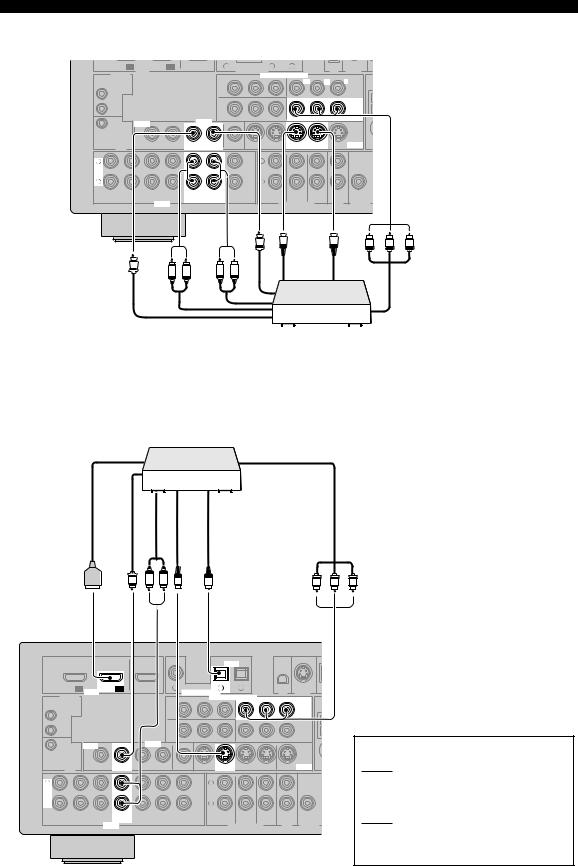
Connections
■ Connecting a DVD recorder, PVR or VCR
|
DVD |
IN1 |
DTV/CBL |
IN2 |
OUT |
|
|
|
HDMI |
|
|
|
|
REMOTE |
|
|
|
|
||
IN |
|
|
|
|
|
|
OUT |
|
|
|
|
|
|
+12V |
|
|
|
|
VIDEO |
|
15mA MAX. VIDEO |
|
|
|
|
||
TRIGGER |
DVD |
DTV/CBL |
IN |
DVR OUT |
||
|
OUT |
|
|
|
|
|
L |
|
|
|
|
|
|
R |
|
|
|
|
|
|
IN |
MD/ |
OUT |
|
|
IN |
OUT |
(PLAY) |
CD-R (REC) |
DVD |
DTV/CBL |
|
DVR |
|
AUDIO
DVD |
|
DTV/CBL |
CD |
|
|
|
|
|
|
1 |
|
|
2 |
3 |
|
|
|
|
|
DIGITAL INPUT |
|
|
|
|
XM |
SIRIUS |
|||
DVD |
|
COMPONENT VIDEO |
|
|
|
DTV/CBL |
|||
PR |
|
PB |
Y |
|
PR |
|
PB |
|
Y |
|
|
|
|
|
|
|
|
|
DVR |
MONITOR OUT |
|
|
|
|
|
|
|
|
|
MONITOR |
DVD |
|
DTV/CBL |
IN |
DVR |
OUT |
MONITOR S VIDEO |
||
OUT |
|
|
|
OUT |
|
||||
|
|
L |
|
|
|
|
|
|
|
|
|
|
|
|
|
CENTER |
|
|
|
|
|
R |
|
|
|
|
|
|
W |
|
|
|
|
|
|
|
|
|
|
|
|
FRONT(6CH) |
|
|
|
SUB |
|
|
|
CD |
|
|
SB(8CH) |
SURROUND |
WOOFER |
ZONE 2 |
|||
|
|
|
|
|
|
|
|||
|
|
|
MULTI CH INPUT |
OUT |
OUTPUT |
||||
V
out Audio
R |
L |
inAudio |
|
inVideo |
|
outvideo-S |
invideo-S |
|
|
|
V |
S |
S |
|
R |
L |
|
|
|
Video out
DVD recorder, PVR or VCR
PR PB Y
Component video out
■ Connecting a set-top box
Satellite receiver, cable TV receiver or HDTV decoder
HDMI out |
|
|
|
|
Component video out |
out Video |
|
out Audio |
out video-S |
|
out Optical |
V |
L |
R |
S |
O |
PR PB Y |
|
|
|
|
|
|
|
|
COAXIAL |
|
|
OPTICAL |
|
|
|
|
|
|
|
|
|
|
|
|
|
|
|
|
|
|
|
|
|
|
|
|
|
|
DVD |
|
DTV/CBL |
CD |
|
|
|
|
|
DVD IN1 |
DTV/CBL |
IN2 |
OUT |
|
1 |
|
|
2 |
3 |
|
|
|
|
|
|
HDMI |
|
|
|
|
DIGITAL INPUT |
|
|
|
|
XM |
SIRIUS |
||
REMOTE |
|
|
|
|
|
DVD |
|
COMPONENT VIDEO |
|
|
DTV/CBL |
|||
|
|
|
|
|
|
PR |
|
PB |
Y |
|
PR |
PB |
|
Y |
IN |
|
|
|
|
|
|
|
|
|
|
|
|
|
|
|
|
|
|
|
|
|
|
|
|
|
|
|
|
DVR |
OUT |
|
|
|
|
|
|
|
|
|
|
|
|
|
|
+12V |
|
|
|
VIDEO |
MONITOR OUT |
|
|
|
|
|
|
|
||
VIDEO |
|
|
|
|
|
|
|
|
|
|
|
|||
15mA MAX. |
|
|
|
|
|
|
|
|
|
|
|
|
|
|
TRIGGER |
DVD |
DTV/CBL |
IN |
DVR |
OUT |
MONITOR |
DVD |
|
DTV/CBL |
IN |
DVR |
OUT |
MONITOR S VIDEO |
|
OUT |
|
|
OUT |
|
|
|
OUT |
|
||||||
L |
|
|
|
|
|
L |
|
|
|
|
|
|
|
|
|
|
|
CENTER |
|
R |
|
|
|
|
|
R |
|
|
W |
|
|
|
|
|
|
|
|
|
|
IN |
MD/ OUT |
|
IN |
OUT |
|
FRONT(6CH) |
SURROUND |
SUB |
|
(PLAY) |
CD-R (REC) |
DVD DTV/CBL |
DVR |
|
CD |
SB(8CH) |
WOOFER |
ZONE 2 |
|
|
|
|
|
||||||
|
|
AUDIO |
|
|
|
MULTI CH INPUT |
OUT OUTPUT |
||
indicates recommended connections
indicates alternative connections
(One for the video connection, and one for the audio connection)
18 En
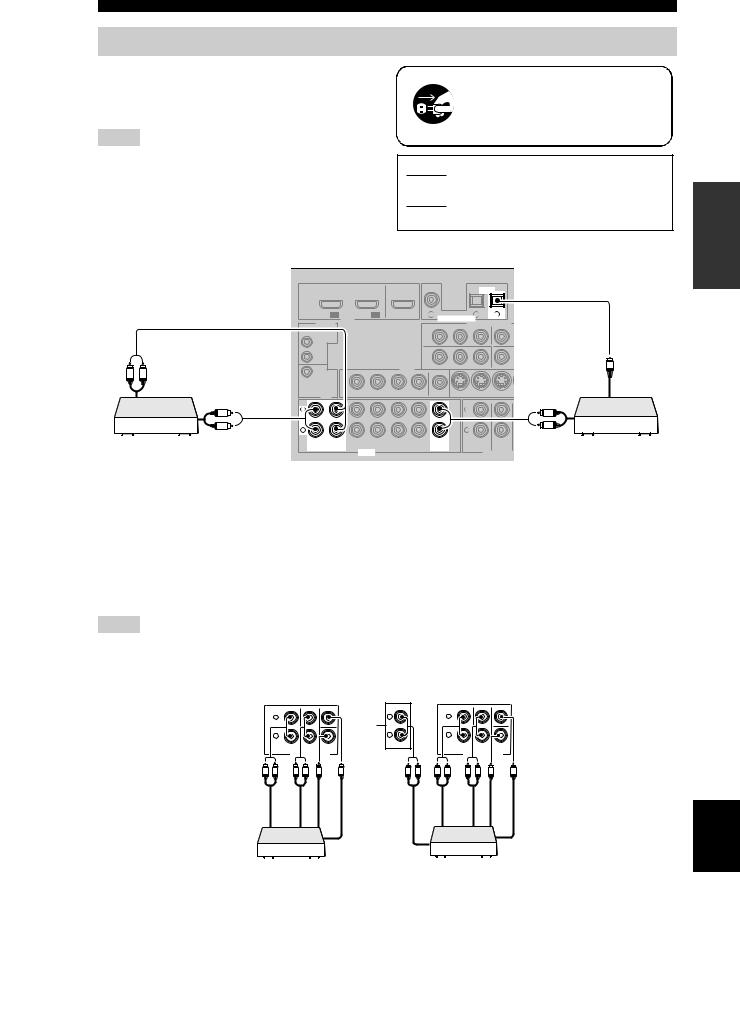
Connecting audio components
Connect the audio components as follows.
■Connecting a CD player and a CD recorder/MD recorder
Notes
•When you connect your CD player via analog and digital connection, priority is given to the signal input at the DIGITAL INPUT jack.
•To make a digital connection to a component other than the default component assigned to each DIGITAL INPUT jack, select the corresponding setting in “INPUT ASSIGNMENT” (see page 71).
Connections
Make sure that this unit and other components are unplugged from the AC wall outlets.
indicates recommended connections
indicates alternative connections
COAXIAL
OPTICAL
|
|
|
|
|
|
|
|
|
|
DVD |
|
DTV/CBL |
CD |
|
|
|
|
|
|
|
DVD |
IN1 |
DTV/CBL IN2 |
OUT |
|
1 |
|
|
2 |
3 |
|
|
|
||
|
|
|
|
HDMI |
|
|
|
|
|
DIGITAL INPUT |
|
|
|
|
|||
|
|
REMOTE |
|
|
|
|
|
DVD |
|
COMPONENT VIDEO |
|
|
|||||
|
|
|
|
|
|
|
|
|
|
PR |
|
PB |
Y |
|
PR |
|
|
|
|
IN |
|
|
|
|
|
|
|
|
|
|
|
|
|
|
|
|
|
OUT |
|
|
|
|
|
|
|
|
|
|
|
|
|
|
|
|
|
+12V |
|
|
|
|
VIDEO |
MONITOR OUT |
|
|
|
|
|
O |
|||
L R |
|
|
|
|
|
|
|
|
|
|
|
|
|
||||
|
15mA MAX. VIDEO |
|
|
|
|
|
|
|
|
|
|
|
|
|
|||
Audio in |
|
TRIGGER |
|
|
|
|
|
|
|
|
|
|
|
Optical out |
|||
|
DVD |
DTV/CBL |
IN |
DVR |
OUT |
MONITOR |
DVD |
|
DTV/CBL |
IN |
DVR |
|
|
||||
|
|
|
OUT |
|
|
|
OUT |
|
|
|
|
||||||
|
L |
L |
|
|
|
|
|
|
|
|
|
L |
|
|
|
L |
|
|
|
|
|
|
|
|
|
|
|
|
|
|
|
|
|
||
|
R |
R |
|
|
|
|
|
|
|
|
|
R |
|
|
|
R |
|
|
Audio out |
|
|
|
|
|
|
|
|
|
|
|
|
Audio out |
|
||
CD recorder or |
|
|
|
|
|
|
|
|
|
|
|
|
|
|
CD player |
||
|
IN |
MD/ |
OUT |
|
|
IN |
|
OUT |
|
|
FRONT(6CH) |
SURROUND |
|||||
|
DVD |
DTV/CBL |
DVR |
CD |
|
|
SB(8CH) |
|
|||||||||
MD recorder |
|
(PLAY) |
CD-R (REC) |
|
|
|
|
|
|
|
|
|
|||||
|
|
|
|
AUDIO |
|
|
|
|
|
|
MULTI CH INP |
|
|
||||
■ Connecting a multi-format player or an external decoder
This unit is equipped with 6 additional input jacks (left and right FRONT, CENTER, left and right SURROUND and SUBWOOFER) for discrete multi-channel input from a multi-format player, external decoder, sound processor or preamplifier.
If you set “INPUT CH” to “8ch” in “MULTI CH SET” (see page 72), you can use the input jacks assigned as “FRONT” in “MULTI CH SET” (see page 72) together with the MULTI CH INPUT jacks to input 8-channel signals.
Connect the output jacks on your multi-format player or external decoder to the MULTI CH INPUT jacks. Be sure to match the left and right outputs to the left and right input jacks for the front and surround channels.
Notes
•When you select the component connected to the MULTI CH INPUT jacks as the input source (see page 36), this unit automatically turns off the digital sound field processor, and you cannot select sound field programs.
•This unit does not redirect signals input at the MULTI CH INPUT jacks to accommodate for missing speakers. We recommend that you connect at least a 5.1-channel speaker system before using this feature.
Multi-format player/External decoder (5.1-channel output)
|
CENTER |
L |
L |
|
*1 |
|
R |
|
|
|
|
|
R |
|
|
FRONT(6CH) |
SURROUND |
SUB |
|
|
|
|
|
SB(8CH) |
WOOFER |
|
|
||
outFront |
|
outSurround |
MULTI CH INPUT |
outCenter |
outFront |
||
R |
L |
R |
outSubwoofer |
||||
L |
|
|
|
|
|||
L R
|
L |
outbackSurround |
R |
L R |
CENTER |
FRONT(6CH) |
SURROUND |
SUB |
SB(8CH) |
WOOFER |
MULTI CH INPUT
outSurround |
L |
outSubwoofer |
|
R |
out Center
Multi-format player/External decoder (7.1-channel output)
*1 The analog audio input jacks assigned as “FRONT” in “MULTI CH SET” (see page 72).
PREPARATION
English
19 En
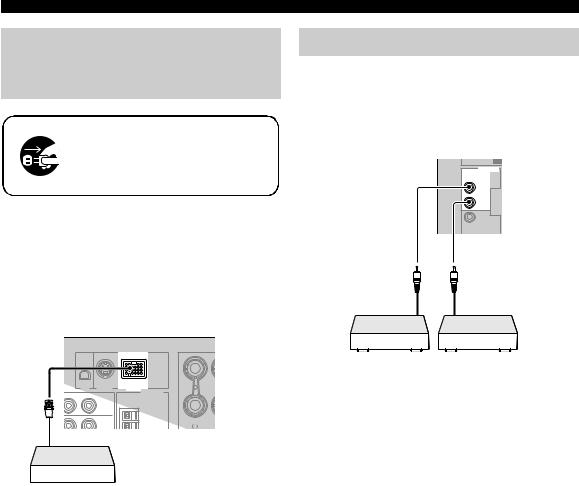
Connections
Connecting a Yamaha iPod™ universal dock or Bluetooth™ adapter
Make sure that this unit and other components are unplugged from the AC wall outlets.
This unit is equipped with the DOCK terminal on the rear panel that allows you to connect a Yamaha iPod universal dock (such as YDS-10, sold separately) or Bluetooth adapter (such as YBA-10, sold separately). Connect a Yamaha iPod universal dock or Bluetooth adapter to the DOCK terminal on the rear panel of this unit using its dedicated cable.
XM |
SIRIUS |
DOCK |
|
|
DTV/CBL |
ANTENNA |
|
PB |
Y |
|
|
|
DVR |
AM |
|
|
|
SURROUND BAC |
|
|
|
|
|
|
|
GND |
R |
Yamaha iPod universal dock or Bluetooth adapter
Using REMOTE IN/OUT jacks
When the components are the Yamaha products and have the capability of the transmission of the remote control signals, connect the REMOTE IN jack and REMOTE OUT jack to the remote control input and output jack with the monaural analog mini cable as follows.
DVD IN1
REMOTE
IN
OUT
+12V 15mA MAX.
Remote |
Remote |
control out |
control in |
Infrared signal |
Yamaha |
receiver or |
component |
Yamaha |
(CD or DVD |
component |
player, etc.) |
y
•If the components have the capability of the SCENE control signals, this unit can automatically activate the corresponding components and start the playback when you use one of the SCENE buttons. Refer to the owner’s manuals for details about the capability of the SCENE control signals of the components.
•If the component connected to the REMOTE OUT jack is not the Yamaha product, set “SCENE IR” in the advanced setup menu to “OFF” (see page 83).
20 En

Using the VIDEO AUX jacks on the front panel
Use the VIDEO AUX jacks on the front panel to connect a game console or a video camera to this unit.
Caution
Be sure to turn down the volume of this unit and other components before making connections.
Connections
Connecting the FM and AM antennas
Both FM and AM indoor antennas are supplied with this unit. Connect each antenna correctly to the designated terminals. In general, these antennas should provide sufficient signal strength.
y
See page 22 for connection information of the supplied AM loop antenna.
Notes
•To reproduce the source signals input at these jacks, select “V-AUX” as the input source.
•When audio signals are input at the AUDIO jacks, PORTABLE jack and the DOCK terminal on the rear panel, the priority order of the input signal is as follows:
1.DOCK
2.PORTABLE
3.AUDIO
Notes
•The AM loop antenna should be placed away from this unit.
•The AM loop antenna should always be connected, even if an outdoor AM antenna is connected to this unit.
•A properly installed outdoor antenna provides clearer reception than an indoor one. If you experience poor reception quality, install an outdoor antenna. Consult the nearest authorized Yamaha dealer or service center about outdoor antennas.
|
|
|
|
|
|
|
|
|
|
|
|
|
VOLUME |
|
Outdoor AM antenna |
|
|
MAIN ZONE |
|
|
|
|
|
|
|
|
|
|
|
|
|
|
Use a 5 to 10 m (16 to 33 |
|
|
ON/OFF |
|
SYSTEM OFF |
|
|
|
|
|
|
|
OPTIMIZER MIC |
|
|
|
ft) vinyl-covered wire |
AM loop |
Indoor FM |
|
|
|
ZONE 2 |
EDIT |
|
CATEGORY |
|
|
|
|
|
INFO |
ZONE |
|
|
extended outdoors from a |
||
|
|
SEARCH MODE |
|
|
|
|
|
|
|
|
|
||||||
|
|
ON/OFF |
PRESET/TUNING |
BAND |
A/B/C/D/E |
|
l PRESET/TUNING/CH h |
|
MEMORY |
|
TUNING AUTO/MAN'L CONTROL |
|
|
window. |
|||
|
|
|
|
|
1 |
2 |
3 |
4 |
|
|
|
|
|
|
antenna |
antenna |
|
|
|
|
|
|
|
|
SCENE |
|
|
|
|
|
|
|
|
|
|
PHONES |
SPEAKERS |
TONE CONTROL |
l PROGRAM h |
STRAIGHT |
DIRECT |
l |
INPUT |
h |
AUDIO SELECT |
VIDEO |
L AUDIO R |
PORTABLE |
|
(supplied) |
(supplied) |
||
|
|
|
|
|
|
|
|
|
|
|
|
|
VIDEO AUX |
|
|
|
|
|
A/B/OFF |
|
|
|
|
|
|
|
|
|
|
|
|
|
|
|
|
SILENT CINEMA |
|
|
|
|
|
EFFECT |
|
|
|
|
|
|
|
|
|
|
|
|
|
VIDEO AUX |
3.5 mm stereo |
|
VIDEO |
L |
AUDIO R |
PORTABLE |
mini plug |
|
|
|
|
|
V |
L |
R |
|
|
Video |
|
|
Audio |
Audio |
output |
|
|
output |
output |
Game console or |
Portable audio |
video camera |
player |
S |
DOCK |
|
L |
ANTENNA |
|
R |
AM |
|
|
|
|
|
GND |
|
|
FM |
|
|
75 |
|
|
UNBAL. |
|
O |
|
|
|
SUB |
|
|
WOOFER |
|
|
CENTER |
|
TPUT |
(U.S.A. model) |
|
Ground (GND terminal)
For maximum safety and minimum interference, connect the antenna GND terminal to a good earth ground. A good earth ground is a metal stake driven into moist earth.
PREPARATION
English
21 En
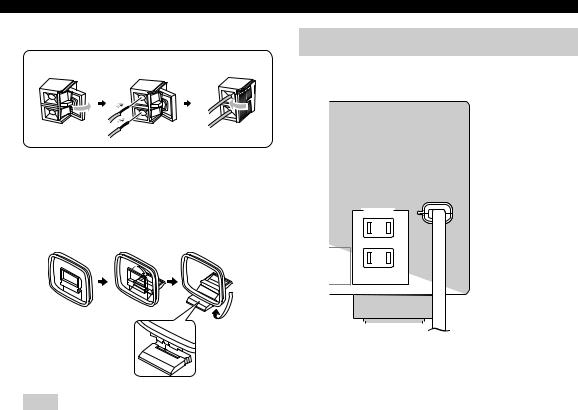
Connections
Connecting the wire of the AM loop antenna
Open the lever |
Insert |
Close the lever |
y
The wire of the AM loop antenna does not have any polarity and you can connect either end of the wire to AM or GND terminal.
Assembling the supplied AM loop antenna
Note
The types of the supplied AM loop antenna is different depending on the models.
Connecting the power cable
Once all connections are complete, plug the power cable into the AC wall outlet.
(U.S.A. model)
AC OUTLETS
SWITCHED
|
|
|
|
Power cable |
|
|
|
|
|
||
|
|
|
|
|
|
■ AC OUTLET(S) (SWITCHED) |
|
||||
Australia model...................................................... |
1 outlet |
||||
Korea model............................................................... |
None |
||||
Other models......................................................... |
2 outlets |
||||
Use these outlet(s) to supply power to any connected components. Connect the power cable of your other components to these outlet(s). Power to these outlet(s) is supplied when this unit is turned on. However, power to these outlet(s) is cut off when this unit is set to the standby mode. For information on the maximum power or the total power consumption of the components that can be connected to these outlet(s), see “Specifications” on page 97.
22 En
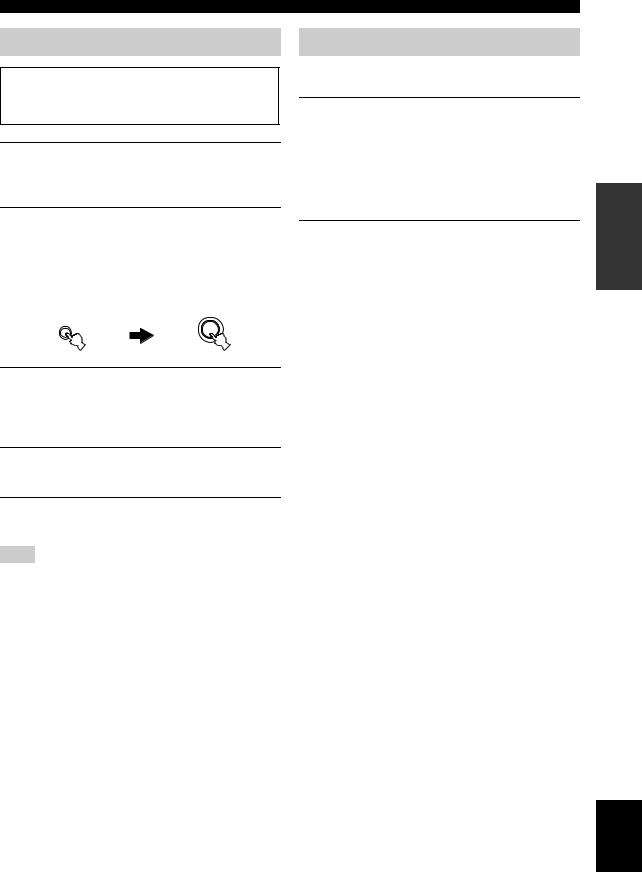
Setting the speaker impedance
Caution
If you are to use 6 ohm speakers, set “SP IMP.” to “6Ω MIN” as follows BEFORE using this unit.
1Press CSYSTEM OFF on the front panel to set this unit to the standby mode.
Refer to the right column for details.
2Press and hold NTONE CONTROL and then press AMAIN ZONE ON/OFF to turn
on this unit.
This unit turns on, and the advanced setup menu appears in the front panel display.
|
While holding |
|
TONE CONTROL |
down |
MAIN ZONE |
|
||
|
|
ON/OFF |
3Press OPROGRAM l/ hto select “SP
IMP.”.
“SP IMP.” and the current speaker impedance setting (“8Ω MIN”) appear in the front panel display.
4Press PSTRAIGHT repeatedly to select “6Ω
MIN”.
5Press AMAIN ZONE ON/OFF to save the new setting and turn off this unit.
Note
The setting you made is reflected next time you turn on this unit.
Connections
Turning on and off the power
■ Turning on this unit
Press AMAIN ZONE ON/OFF (or HPOWER) to turn on this unit.
y
When you turn on this unit, there will be a 4 to 5-second delay before this unit can reproduce sound.
■ Set this unit to the standby mode
Press AMAIN ZONE ON/OFF (or
ISTANDBY) to set this unit to the standby mode.
In the standby mode, this unit consumes a small amount of power in order to receive infrared signals from the remote control.
y
You can set the main zone and zone 2 to the standby mode simultaneously by pressing CSYSTEM OFF.
PREPARATION
English
23 En
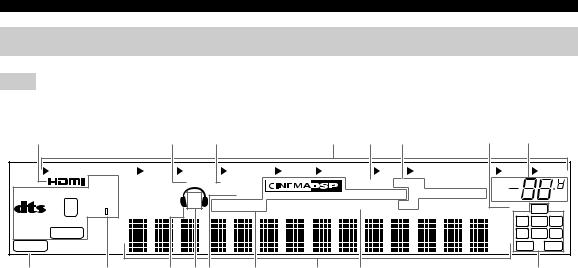
Connections
Front panel display
Note
The XM and SIRIUS indicator is only applicable to the U.S.A. and Canada models and the cursor on the left of the XM indicator or SIRIUS indicator lights up only when “XM” or “SIRIUS” is selected as the input source.
1 |
|
2 |
|
3 |
|
4 |
5 |
6 |
|
7 |
8 |
|
|||
MULTI CH |
DVR |
V-AUX |
DTV/CBL |
DVD |
MD/CD-R |
CD |
TUNER |
|
XM |
SIRIUS |
|||||
|
qEX |
|
DOCK |
|
ENHANCER |
|
|
YPAO MEMORY |
|
VOL. |
|
|
|||
|
qDIGITAL |
|
SP |
|
ZONE 2 |
|
|
VIRTUAL |
AUTO TUNED STEREO |
MUTE |
|
|
dB |
||
96 |
|
|
|
|
|
|
|
||||||||
|
|
A B |
SILENT CINEMA |
|
|
SLEEP |
HOLD |
|
|
96/24 |
LFE |
|
|||
ES 24 |
qPL x |
|
|
|
|
|
|
|
|
|
|
|
|
||
|
|
|
|
|
|
|
|
|
|
ft |
L C R |
||||
MATRIX DISCRETE |
|
|
|
|
|
|
|
|
|
|
|
||||
neural |
|
|
|
|
|
|
|
|
|
|
ms |
SL |
SB |
SR |
|
PCM |
|
|
|
|
|
|
|
|
|
|
|
SBL |
|
SBR |
|
|
|
|
|
|
|
|
|
|
|
|
dB |
|
|||
9 |
0 |
A BC |
D |
E |
|
F |
|
|
|
|
|
G |
|
||
1 HDMI indicator
Lights up when the signal of the selected input source is input at the HDMI IN jacks (see page 14).
2 DOCK indicator
•Lights up when you station your iPod in a Yamaha iPod universal dock (such as the YDS-10, sold separately) connected to the DOCK terminal of this unit (see page 20) and V-AUX is selected as the input source. The DOCK indicator also lights up when this unit is charging the battery of the stationed iPod in the standby mode.
•Flashes while the connected Yamaha Bluetooth adapter (such as YBA-10, sold separately) and the Bluetooth component is in the paring (see page 61) or the Bluetooth adapter is searching the Bluetooth component (see page 61).
•Lights up while the connected Yamaha Bluetooth adapter is connected to the Bluetooth component (see page 20).
3 ENHANCER indicator
Lights up when the Compressed Music Enhancer mode is selected (see page 40).
4 Input source indicators
The corresponding cursor lights up to show the currently selected input source.
5 YPAO indicator
Lights up when you run “AUTO SETUP” and when the speaker settings set in “AUTO SETUP” are used without any modifications (see page 26).
6 Tuner indicators
Lights up when this unit is in the FM, AM, XM Satellite Radio or SIRIUS Satellite Radio tuning mode (see pages 45 to 58).
7 96/24 indicator
Lights up when a DTS 96/24 signal is input to this unit.
8MUTE indicator and VOLUME level indicator
• The MUTE indicator flashes while the MUTE function is on (see page 37).
• Indicates the current volume level.
9PCM indicator
Lights up when this unit is reproducing PCM (Pulse Code Modulation) digital audio signals.
0 Decoder indicators
The respective indicator lights up when any of the decoders of this unit function.
A Headphone indicator
Lights up when headphones are connected (see page 37).
B SP A B indicators
Light up according to the set of front speakers activated (see page 35).
SP A: The FRONT A speakers are activated. SP B: The FRONT B speakers are activated.
C ZONE2 indicator
Lights up when Zone 2 is turned on (see page 80).
24 En

DCINEMA DSP indicator
Lights up when you select a sound field program (see page 41).
VIRTUAL indicator
Lights up when Virtual CINEMA DSP is active (see page 41).
SILENT CINEMA indicator
Lights up when headphones are connected and a sound field program is selected (see page 41).
EMulti-information display
Shows the name of the current sound field program and other information when adjusting or changing settings.
F SLEEP indicator
Lights up while the sleep timer is on (see page 39).
G Input channel and speaker indicators
LFE LFE indicator
L C R
SL SB SR Input channel indicators
SBL SBR
Input channel indicators
•Indicate the channel components of the current digital input signal.
•Light up or flash according to the settings of the speakers when this unit is in the automatic setup procedure (see page 26) or the speaker level setting procedure in the “SP LEVEL” (see page 67).
Connections
■ Using the remote control
The remote control transmits a directional infrared ray. Be sure to aim the remote control directly at the remote control sensor on this unit during operation.
Approximately |
30º |
30º |
6 m (20 ft) |
|
PREPARATION |
|
|
1Infrared window
Outputs infrared control signals. Aim this window at the component you want to operate.
y
To set the remote control codes for other components, see page 78.
Notes
•Do not spill water or other liquids on the remote control.
•Do not drop the remote control.
•Do not leave or store the remote control in the following types of conditions:
–places of high humidity, such as near a bath
–places of high temperature, such as near a heater or stove
–places of extremely low temperatures
–dusty places
English
25 En
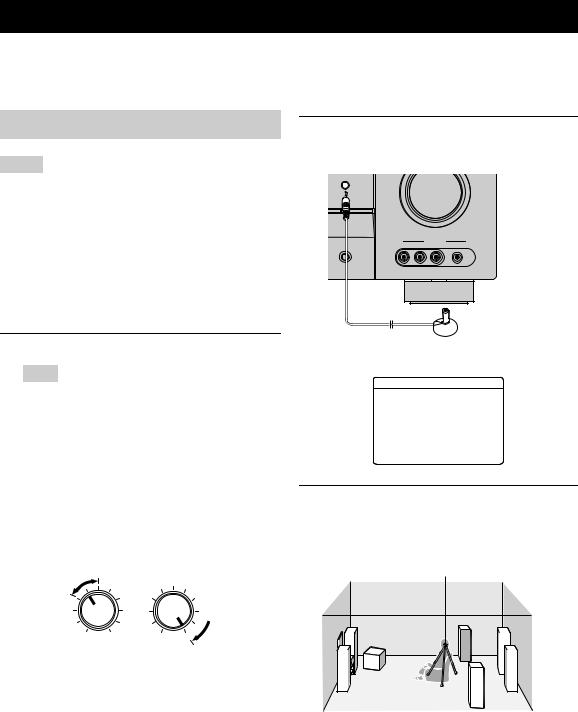
Optimizing the speaker setting for your listening room
This unit employs the YPAO (Yamaha Parametric Room Acoustic Optimizer) technology which lets you avoid troublesome listening-based speaker setup and achieves highly accurate sound adjustments automatically. The supplied optimizer microphone collects and this unit analyzes the sound your speakers produce in your actual listening environment.
Using AUTO SETUP |
2 Connect the supplied optimizer microphone |
|
to the OPTIMIZER MIC jack on the front |
Notes |
panel. |
|
|
|
OPTIMIZER MIC |
• Be advised that it is normal for loud test tones to be output |
|
during the “AUTO SETUP” procedure. |
ZONE |
• To achieve the best results, make sure the room is as quiet as |
/MAN'L CONTROL |
|
|
possible while the “AUTO SETUP” procedure is in progress. If |
|
there is too much ambient noise, the results may not be |
VIDEO AUX |
|
VIDEO L AUDIO R PORTABLE |
satisfactory. |
AUDIO SELECT |
|
y
You can run “AUTO SETUP” using the system menu that appears in the OSD or in the front panel display. This manual uses the OSD illustrations to explain the “AUTO SETUP” procedure.
1 Make sure of the following check points.
Note
Before starting the automatic setup, check the following check points.
Speakers are connected appropriately.
Headphones are disconnected from this unit.
This unit and the video monitor are turned on.
This unit is selected as the video input source of the video monitor.
The connected subwoofer is turned on and the volume level is set to about half way (or slightly less).
The crossover frequency controls of the connected subwoofer is set to the maximum.
VOLUME |
CROSSOVER |
||
|
|
HIGH CUT |
|
MIN |
MAX |
MIN |
MAX |
Controls of a subwoofer (example)
FRONT A speakers are selected as the front speaker system (see page 35).
The room is sufficiently quiet.
 Optimizer microphone
Optimizer microphone
The following display appears in the OSD.
AUTO SETUP
SETUP;;;;;;;AUTO
.START
Automatic
Processing of all item
[p]/[p]:Up/Down [p]/[[]:Select
3Place the optimizer microphone at your normal listening position on a flat level surface with the microphone heading upward.
Optimizer microphone
y
It is recommended that you use a tripod (etc.) to affix the optimizer microphone at the same height as your ears would be when you are seated in your listening position. You can use the attached screw of a tripod (etc.) to fix the optimizer microphone to the tripod (etc.).
26 En
